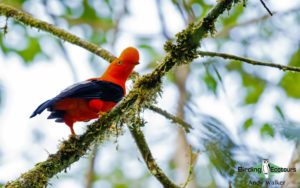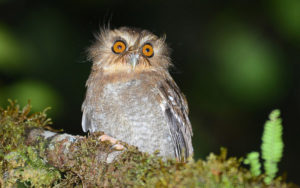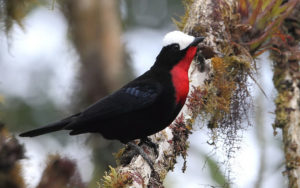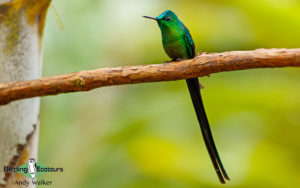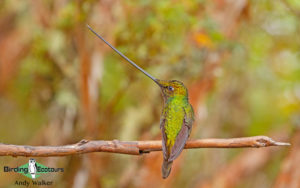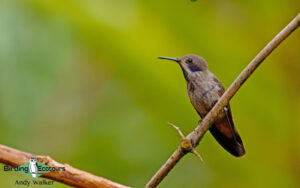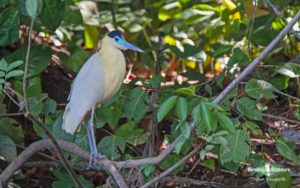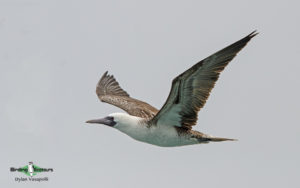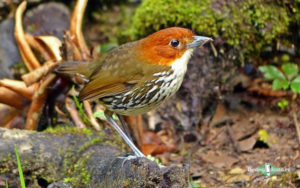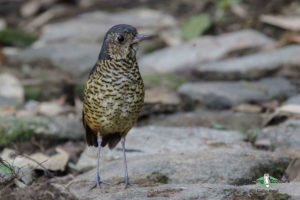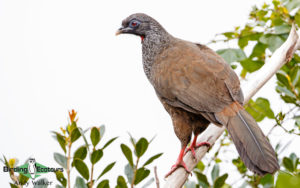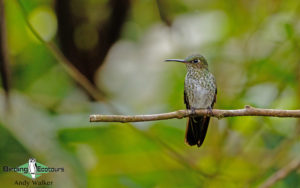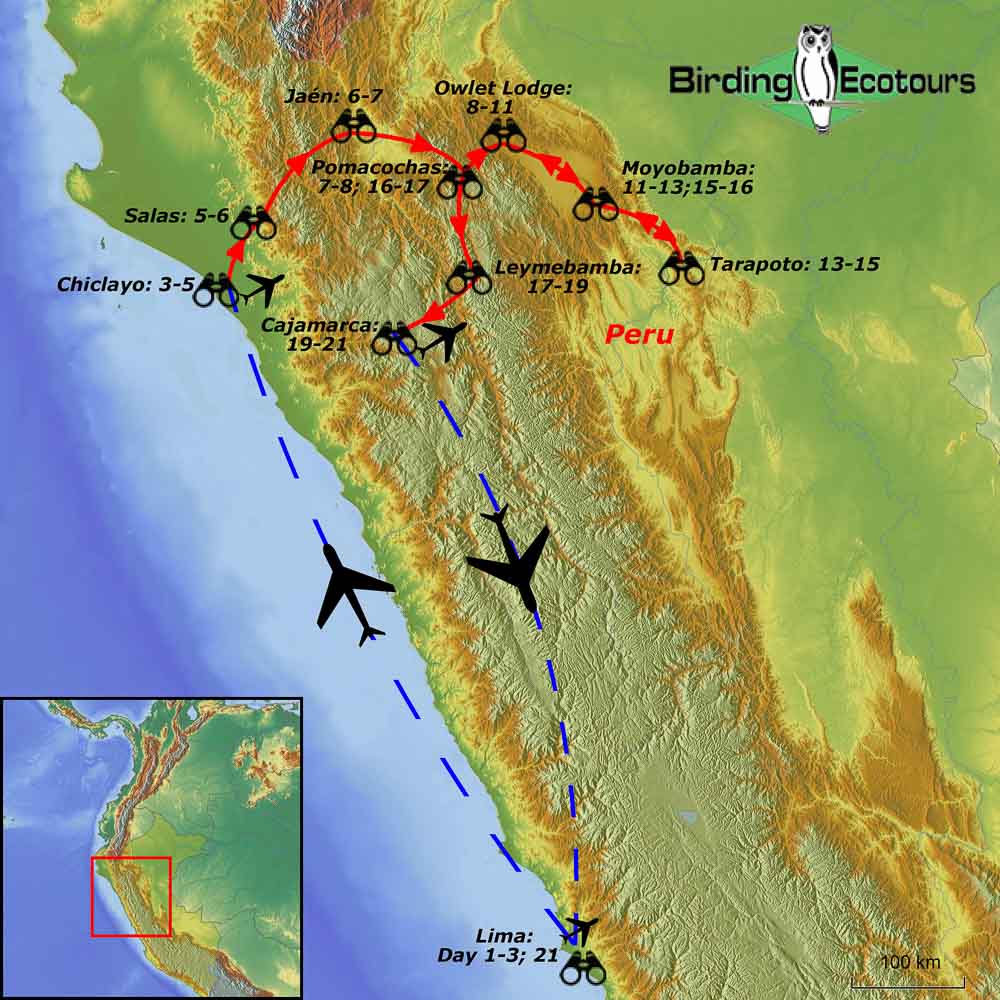Birding Tour Peru: Comprehensive Northern Peru
Comprehensive Northern Peru
May 2027
This expansive tour of the magnificent north of Peru will lead us through all of the most rewarding birding hotspots of this astounding area brimming with avian riches. Major highlights will be the Owlet Lodge in the Abra Patricia Mountains and the Marvelous Spatuletail, perhaps the most beautiful hummingbird in the world. Other targets will include several range-restricted species, such as the endemics Peruvian Plantcutter and White-winged Guan in the deciduous habitat of the Northwest, the endemic and shy Little Inca Finch and Maranon Crescentchest in the dry Marañón Valley, and a high diversity of species such as White-capped Tanager, Golden-headed Quetzal, Masked Trogon, Sword-billed Hummingbird, and the endemic Yellow-scarfed Tanager in the Abra Patricia humid montane forest.
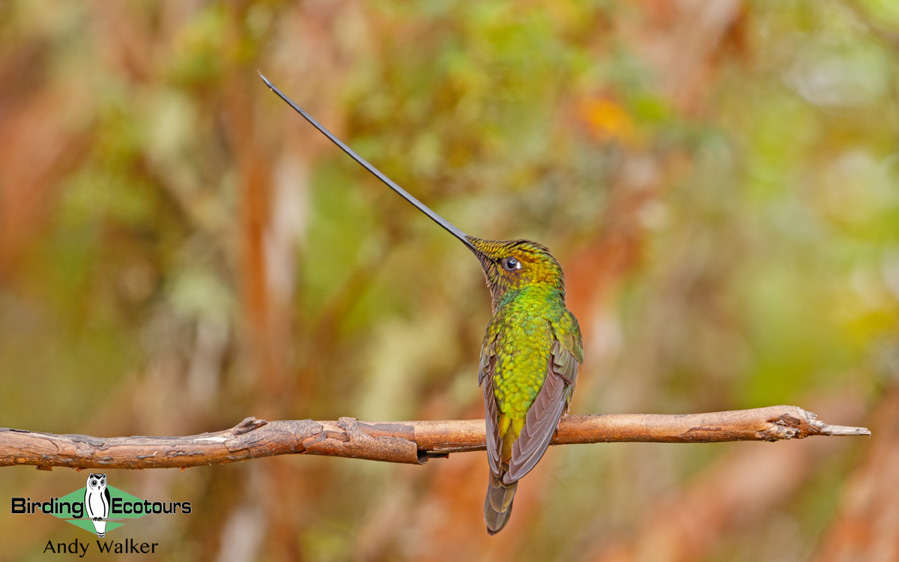
We will visit antpitta stations, where one can see the endemic Rusty-tinged, Chestnut, and Ochre-fronted Antpittas on the same day, and continue exploring the upper tropical lowlands, where wonderful species such as Andean Cock-of-the-rock and several tanagers, such as Bay-headed, Paradise, Golden, Saffron-crowned, Flame-faced, Black-faced, White-winged, Magpie, Yellow-backed, Guira, Spotted, Yellow-bellied, and the endemic Huallaga Tanagers can be seen.
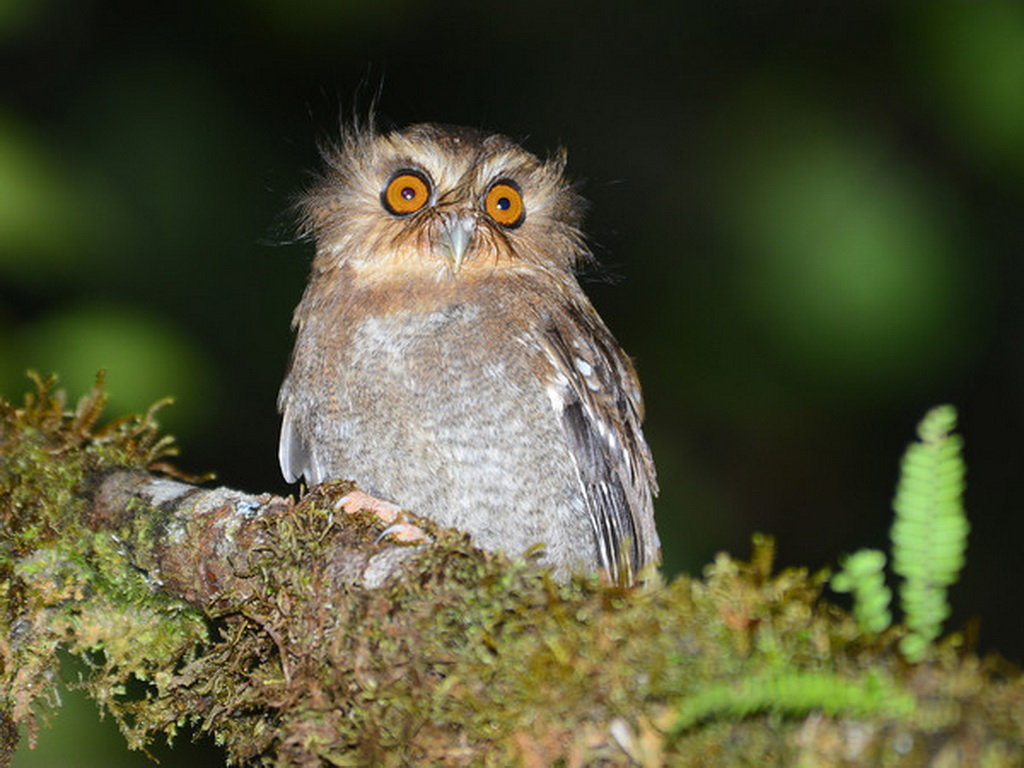
Other classic tropical Amazonian birds include Golden-collared Toucanet, Channel-billed and White-throated Toucans, Chestnut-eared Aracari, Green-backed Trogon, Rufous Motmot, Bluish-fronted Jacamar, Violaceous Jay, Sungrebe, Golden-headed Manakin, Fiery-throated Fruiteater, and the endemic Mishana Tyrannulet. The upper Amazon forest will provide you with views of Hoatzin, Oilbird, White-backed Fire-eye, the endemic Ash-throated Antwren, White-flanked Antwren, Chestnut-throated, Cinereous-breasted, Dusky, and Dark-breasted Spinetails, and if we are lucky enough to find army ant swarms we could be rewarded with views of the splendid White-plumed Antbird.
Finally we will explore the Utcubamba and Marañón valleys and the Cajamarca region, looking not only for a classic set of Andean species, such as Andean Condor, Torrent Duck, White-capped Dipper, and Giant Hummingbird, but also for a very poorly known set of range-restricted endemics, such as Russet-mantled Softtail, Buff-bridled Inca Finch, Grey-winged Inca Finch, Yellow-faced Parrotlet, and Grey-bellied Comet.
Due to the high diversity of species this trip might provide over ten species of owls and 55 species of hummingbirds. It all depends on luck and the efforts of our friendly leaders and enthusiastic participants. We invite you to visit one of the more rewarding and adventurous birding trips in South America!
Itinerary (21 days/20 nights)
Day 1. Arrival in Lima
You will arrive at the Jorge Chávez International Airport of Lima and be transferred to your hotel. No activities are included on day 1, since most international flights arrive in Lima late in the evening. If you arrive on an early flight you might be charged an extra accommodation fee for an early check-in at the hotel, or we can organize an additional birding morning near the city.
Overnight: Hotel in Lima
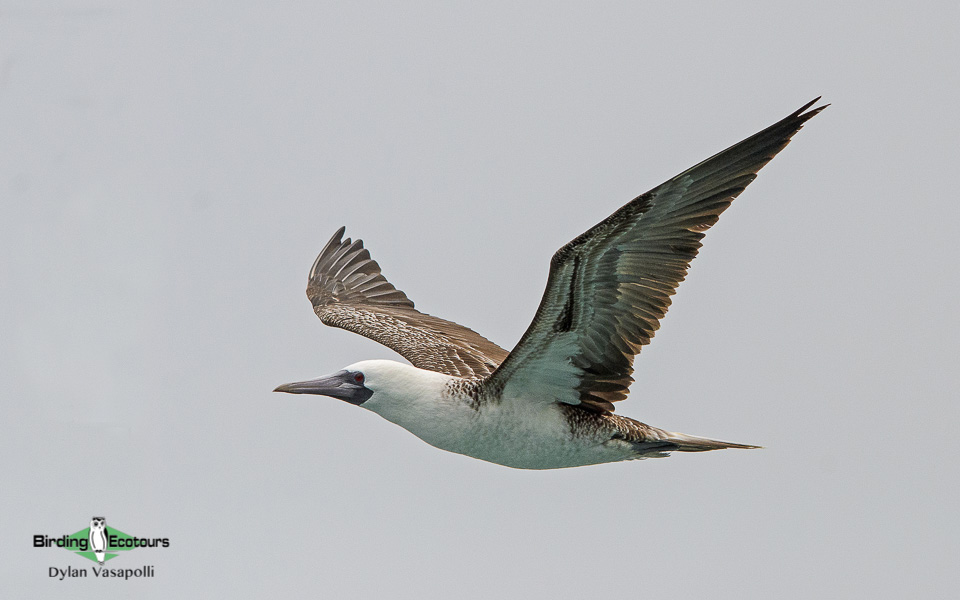
Day 2. Birding Pucusana and Pantanos de Villa
We will have an easy morning visiting the fishing village of Pucusana, 60 kilometers/37 miles south of the city. Here we will have the chance to see many coastal birds and Humboldt Current specialists like Inca Tern, Belcher’s Gull, Peruvian Pelican, Peruvian Booby, Blue-footed Booby, Guanay Cormorant, Red-legged Cormorant, Blackish Oystercatcher, Humboldt Penguin, and the endemic Peruvian Seaside Cinclodes.
Later we will drive to the marshes of the Pantanos de Villa Wildlife Refuge, where we will look for Great Grebe, Andean Coot, Cinnamon Teal, White-cheeked Pintail, Peruvian Meadowlark, Many-colored Rush Tyrant, Wren-like Rushbird, Grassland Yellow Finch, Grey-headed Gull, American Oystercatcher, and Grey Gull.
Overnight: Hotel in Lima
Day 3. Birding Lomas de Lachay and flight to Chiclayo
Today we will have an early start driving north of Lima to the Lomas de Lachay National Reserve, where we will look for a number of endemics like Cactus Canastero and, if we are lucky, Thick-billed Miner and the nomadic Raimondi’s Yellow Finch. Other birds include Greyish Miner, Short-tailed Field Tyrant, Band-tailed Sierra Finch, Least Seedsnipe, Masked Yellowthroat, Collared Warbling Finch, Black-chested Buzzard-Eagle, Vermilion Flycatcher, and Mountain Parakeet. We will return to Lima and connect with our afternoon flight to the city of Chiclayo.
Overnight: Casa Andina Select Chiclayo, Chiclayo
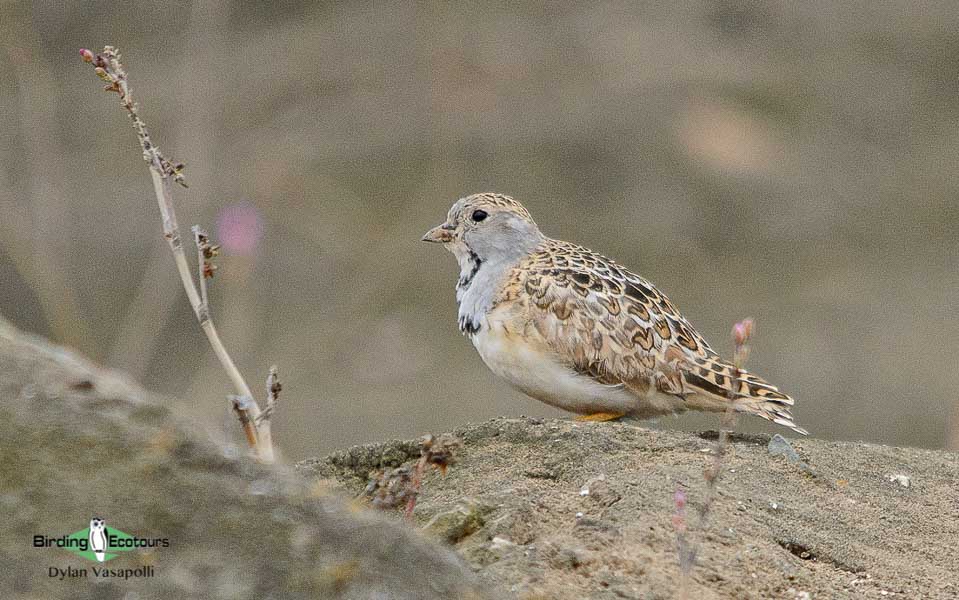
Day 4. Birding the Bosque de Pómac Historic Sanctuary
We will explore the Bosque de Pómac Historic Sanctuary, which is an area of large deciduous mesquite woodland. Here we spend a nice morning, looking for several range-restricted species, including the endemic Rufous Flycatcher, Peruvian Plantcutter, and Tumbes Tyrant. Other birds include Tumbes Swallow, Grey-and-white Tyrannulet, Scarlet-backed Woodpecker, Streak-headed Woodcreeper, White-edged Oriole, Lineated Woodpecker, White-tailed Jay, Fasciated Wren, Superciliated Wren, Short-tailed Field Tyrant, Cinereous Finch, Tawny-crowned Pygmy Tyrant, Pacific Hornero, Collared Antshrike, Baird’s Flycatcher, Pacific Parrotlet, and Amazilia Hummingbird. After lunch we will explore the coastal shores of Chiclayo in search of Gull-billed Tern and, with luck, Peruvian Tern.
Overnight: Casa Andina Select Chiclayo, Chiclayo
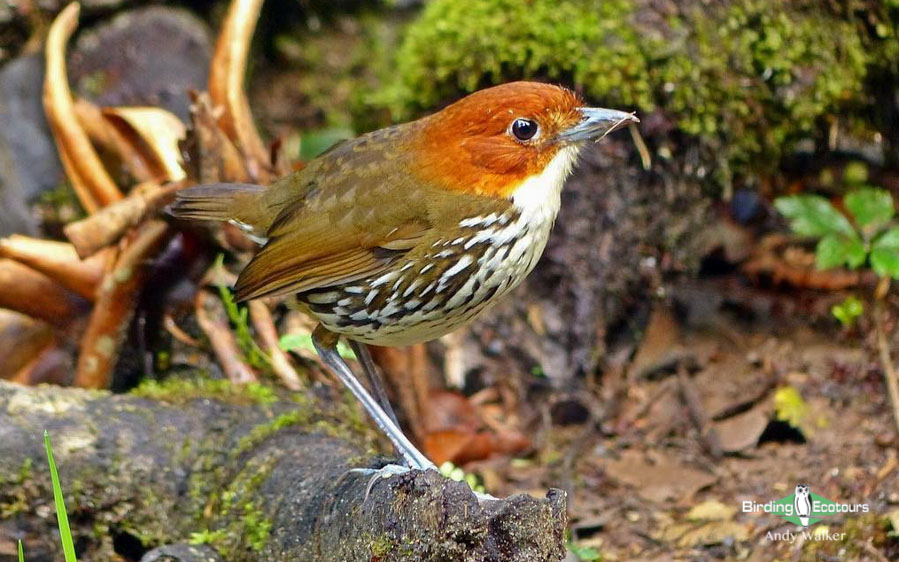
Day 5. Birding the Laquipampa Wildlife Refuge, transfer to Salas
We will explore the Laquipampa Wildlife Reserve above the mountains of Chiclayo in search of the endemic and Endangered (IUCN) White-winged Guan and also of White-headed Brushfinch, White-winged Brushfinch, Red-masked Parakeet, Elegant Crescentchest, Plumbeous-backed Thrush, Pacific Elaenia, Black-capped Sparrow, Grey-and-gold Warbler, Henna-hooded Foliage-gleaner, Rufous-necked Foliage-gleaner, Tumbes Sparrow, Ecuadorian Trogon, Whooping Motmot, Short-tailed Woodstar, and Short-tailed Swift. Later we will transfer to Salas, where we will spend an overnight at the charming Los Faiques guesthouse. Before dusk we will look for Lesser Nighthawk and after a delicious dinner for West Peruvian Screech Owl.
Overnight: Los Faiques, Salas
Day 6. Birding the Porculla mountain pass, transfer to Jaén
Today we will have a very early start to explore the Porculla mountain pass (the lowest Peruvian mountain pass), where we will look for White-winged Brushfinch, Line-cheeked Spinetail, Black-cowled Saltator, Chapman’s Antshrike, Black-and-white Seedeater, Grey-chinned Hermit, Three-banded Warbler, Elegant Crescentchest, the endemic Piura Chat-Tyrant, Tumbesian Tyrannulet, Henna-hooded Foliage-gleaner, Chestnut-crowned Antpitta, and Ecuadorian Piculet. If we are extremely lucky, we might find some rarities such as Grey-headed Antbird. After some hours of birding in this area we will head to the heat of Jaén. In the afternoon we will explore the Yanahuanca area in search of the endemic Spot-throated Hummingbird and of Anthony’s Nightjar.
Overnight: Hotel El Bosque, Jaén
Day 7. Birding Bosque de Yanahuanca, transfer to Gocta
An early start will take us back to Bosque de Yanahuanca, which is located near the city of Jaén. Here we will look for the localized Maranon Spinetail, Chinchipe Spinetail, Red Pileated Finch, the endemic Spot-throated Hummingbird, Green-backed Becard, Black-and-white Becard, Striped Cuckoo, Sooty-crowned Flycatcher, Ecuadorian Ground Dove, Maranon Crescentchest, and the endemic and shy Little Inca Finch. We will drive along the Utcubamba Valley with good chances for Blue Ground Dove, Fasciated Tiger Heron, Pied Plover, Yellow-browed Sparrow, Striated Heron, Savanna Hawk, Mitred Parakeet, Amazon Kingfisher, and Maranon Thrush.
In the afternoon we will drive to Huembo where we will check in and spend the remainder of the afternoon enjoying the hummingbird feeders where we may find some of the species listed under Day 8 below.
Overnight: Huembo Lodge, Pomacochas
Day 8. Huembo hummingbird feeders and transfer to the Owlet Lodge
We will wake up early and bird around the famous Huembo feeding center, where we will look for the endemic Marvelous Spatuletail, Bronzy Inca, Andean Emerald, Chestnut-breasted Coronet, Sparkling Violetear, Lesser Violetear, Violet-fronted Brilliant, White-bellied Woodstar, Little Woodstar, White-bellied Hummingbird, and Green-tailed Trainbearer. Here we might also have good chances for Black-throated Toucanet as well as Chestnut-capped Brushfinch, Northern White-crowned Tapaculo, Sierran Elaenia, Buff-browed Foliage-gleaner, and Azara’s Spinetail. Later we will drive to the Abra Patricia area and arrive at the Owlet Lodge for a three-night stay.
Overnight: Owlet Lodge
Day 9. Owlet Lodge
Today we will explore the trails of the lodge, looking for species such as Grass-green Tanager, the endemic Yellow-scarfed Tanager, Masked Flowerpiercer, the endemic Lulu’s Tody-Flycatcher, Green-and-black Fruiteater, Black-throated Tody-Tyrant, Variable Antshrike, Russet-crowned Warbler, Grey-breasted Wood Wren, Rufous Spinetail, the endemic Rufous-vented Tapaculo, Rufous-headed Pygmy Tyrant, Spotted Barbtail, Blue-winged Mountain Tanager, Streaked Tuftedcheek, Pearled Treerunner, White-banded Tyrannulet, Capped Conebill, and Strong-billed, Montane, and Olive-backed Woodcreepers. The hummingbird feeders of the lodge provide views of Emerald-bellied Puffleg, Bronzy Inca, Collared Inca, Fawn-breasted Brilliant, White-bellied Woodstar, Long-tailed Sylph, and Chestnut-breasted Coronet. In the afternoon we will explore the steep Owlet Trail, where we will look for the enigmatic, endemic Long-whiskered Owlet. If we are lucky we might encounter Rufous-bellied Nighthawk.
Overnight: Owlet Lodge
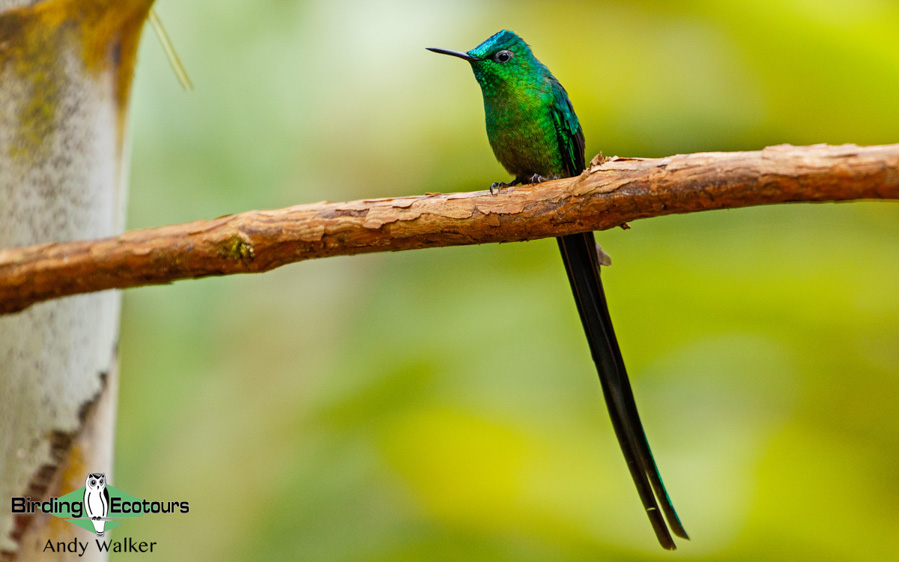
Day 10. Owlet Lodge and Fundo Alto Nieva
After having had a full day with no driving yesterday, today we will explore the lowest parts of the mountain pass, especially the recently new Fundo Alto Nieva, a private reserve, where we will enjoy hummingbird feeders with Greenish Puffleg, Rufous-vented Whitetip, Peruvian Racket-tail, Green-fronted Lancebill, and the spectacular Royal Sunangel. But not only hummingbirds are the attraction of this reserve, but we also will have a chance to see the endemic Rusty-tinged Antpitta coming to a worm feeder. Other birds at lower elevations include the range-restricted Bar-winged Wood Wren, Cinnamon-breasted Tody-Tyrant, Crimson-mantled Woodpecker, Olive-chested Flycatcher, Blue-naped Chlorophonia, Flame-faced Tanager, and Golden-eyed Flowerpiercer. We will return to the lodge for lunch, and after some rest we will get back to Fundo Alto Nieva to look for the endemic and secretive Ochre-fronted Antpitta, which attends the worm feeders only in the afternoon. Before dusk we will try for Cinnamon Screech Owl and Lyre-tailed Nightjar and have another chance for Long-whiskered Owlet (in case we need it).
Overnight: Owlet Lodge
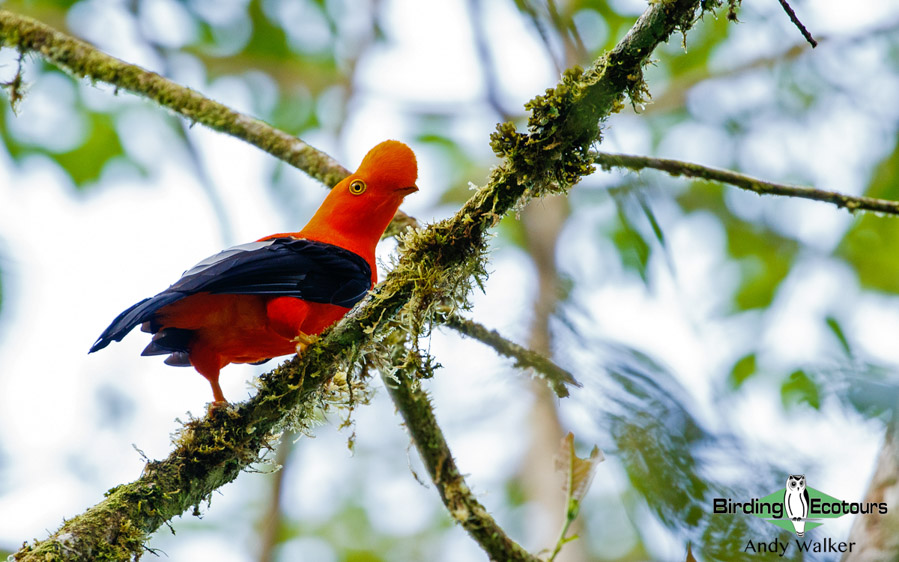
Day 11. Afluentes and Moyobamba
Today, we will leave the mountains and head to lower elevations to the upper tropical forest. Here we will focus on mixed-flock species, including colorful birds such as Golden Tanager, Paradise Tanager, Bay-headed Tanager, Spotted Tanager, Golden-eared Tanager, Vermilion Tanager, White-lined Tanager, Magpie Tanager, and also Versicolored Barbet, Ash-browed Spinetail, Dark-breasted Spinetail, Montane Foliage-gleaner, Lined Antshrike, White-backed Fire-eye, Northern White-crowned Tapaculo, Yellow-breasted Antwren, Grey-mantled Wren, and Scale-crested Pygmy Tyrant. We will also have another chance for Speckle-chested Piculet and the fabulous Andean Cock-of-the-rock.
Later we will reach Rioja in the flat lowlands, where we will look for the secretive Point-tailed Palmcreeper, Spot-breasted Woodpecker, Gilded Barbet, Yellow-tufted Woodpecker, Hauxwell’s Thrush, Cobalt-winged Parakeet, and Chestnut-bellied Seedeater.
Finally we will arrive in the Moyobamba area in the tropical Amazon foothills at our basic but good accommodation, the Waqanki Lodge. Here we will spend the afternoon admiring the hummingbird feeders, looking for Rufous-crested Coquette, Blue-tailed Emerald, Black-throated Mango, Long-billed Starthroat, White-necked Jacobin, Brown Violetear, Long-tailed Hermit, Black-throated Hermit, Sapphire-spangled Emerald, Golden-tailed Sapphire, Wire-crested Thorntail, White-chinned Sapphire, and with luck even Amethyst Woodstar.
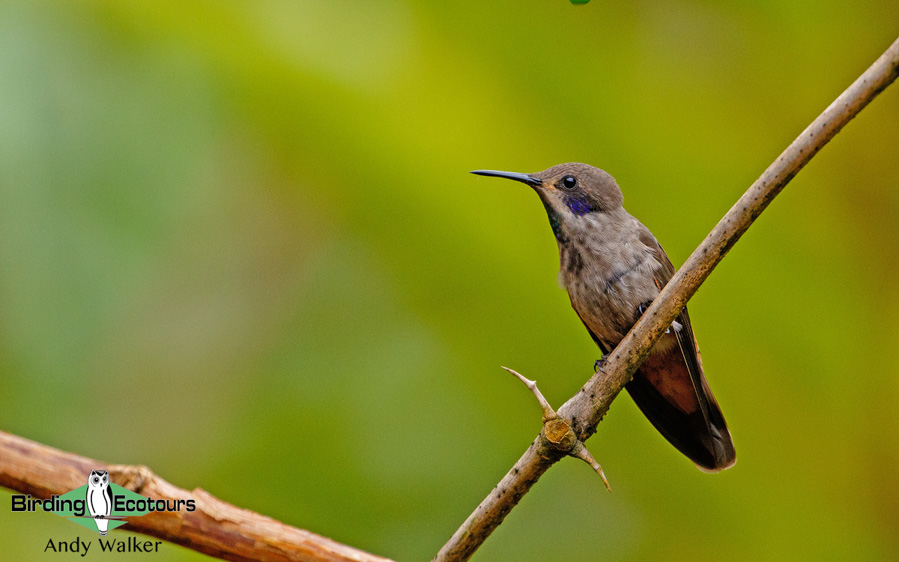
The area around Waqanki provides good chances for owls, including Band-bellied Owl, Stygian Owl, Striped Owl, Black-banded Owl, Foothill Screech Owl, Ferruginous Pygmy Owl, and Tropical Screech Owl. But getting the largest number of them depends very much on how hard we work and on luck. They have different times where they are active at night, so hard work is required to track down most of them.
Overnight: Waqanki Lodge, Moyobamba
Day 12. Waqanki and Moyobamba
Today we will hike up the mountains above Moyobamba along a steep trail, looking for Fiery-capped Manakin, Fiery-throated Fruiteater, Scarlet-breasted Fruiteater, Black-and-white Tody-Flycatcher, Tawny-throated Leaftosser, White-bellied Pygmy Tyrant, the endemic Mishana Tyrannulet, White-lored Tyrannulet, Spot-winged Antbird, Northern Chestnut-tailed Antbird, Plain-winged Antshrike, Peruvian Warbling Antbird, Channel-billed Toucan, Golden-collared Toucanet, Rufous Motmot, Blue-rumped Manakin, Buff-throated Tody-Tyrant, and the endemic and Endangered (IUCN) Ash-throated Antwren. In the evening we will keep trying for owls and for Spot-tailed Nightjar and Ocellated Poorwill.
Overnight: Waqanki Lodge, Moyobamba
Day 13. Boat ride on the Rio Negro and transfer to Tarapoto
Today we will have an easy boat ride along the narrow Rio Negro channels, looking for species such as Band-tailed Antbird, Blue-crowned Trogon, Spangled Cotinga, Epaulet Oriole, Buff-throated Woodcreeper, Barred Antshrike, Great Antshrike, Pale-legged Hornero, Rufous-breasted Hermit, Capped Heron, Cocoi Heron, Limpkin, and with luck the most wanted Sungrebe. After the boat ride we will check some grasslands around Moyobamba for Black-faced Tanager, Wedge-tailed Grass Finch, Black-billed Seed Finch, Greyish Saltator, and with luck Russet-crowned Crake. We will leave Moyobamba on the way to Tarapoto and stop to look for Oilbird en route. We will arrive at Tarapoto for an overnight.
Overnight: Hotel Rio Shilcayo, Tarapoto
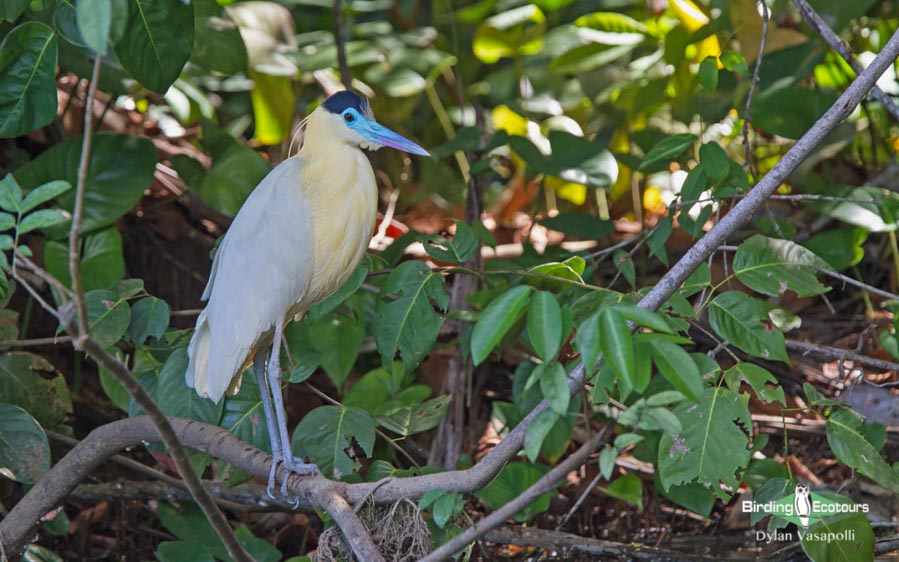
Day 14. Cordillera Escalera Regional Conservation Area
We will leave the hotel and head toward the buffer zone of the Cordillera Escalera protected zone. In this area we will have good views of Cliff Flycatcher, White-tipped Swift, Slaty-capped Shrike-Vireo, Slate-colored Grosbeak, and if we are lucky Military Macaw. We will arrive at a local hummingbird center, where we will have nice views of the endemic Koepcke’s Hermit, Gould’s Jewelfront, Black-throated Brilliant, and Pale-tailed Barbthroat. This nice center located in the upper Amazon forest also provides great views of White-throated Toucan, Violaceous Jay, Magpie Tanager, and some understory species such as Carmiol’s Tanager, Golden-headed Manakin, Ruddy Foliage-gleaner, Black-faced Antthrush, White-breasted Wood Wren, Spot-winged Antbird, Green-backed Trogon, and if we are lucky to find army ant swarms the stunning White-plumed Antbird and Bicolored Antbird.
Overnight: Hotel Rio Shilcayo, Tarapoto
Day 15. Huallaga River and transfer to Moyobamba
The dry areas of Tarapoto along the Huallaga River are good for species like Bluish-fronted Jacamar, White-browed Antbird, Northern Slaty Antshrike, Rufous Casiornis, Sulphur-bellied Tyrant-Manakin, White-bellied Pygmy Tyrant, Rusty-backed Antwren, Rufous-winged Antwren, Inca Jay, Coraya Wren, Ashy-headed Greenlet, White-winged Swallow, White-banded Swallow, and with some luck Comb Duck, Sand-colored Nighthawk, and Black-bellied Whistling Duck. Later we will drive back to Moyobamba for an overnight
Overnight: Hotel Puerto Mirador, Moyobamba
Day 16. Reserva Arena Blanca and transfer to Pomacochas
A predawn start will take us to visit the recently opened Reserva Arena Blanca, where we will visit the feeders, which attract Rufous-breasted Wood Quail, Cinereous Tinamou, Little Tinamou, Orange-billed Sparrow, and Grey-cowled Wood Rail. The hummingbird feeders attract Blue-fronted Lancebill, Amethyst Woodstar, Long-billed Starthroat, Wire-crested Thorntail, Many-spotted Hummingbird, and a few others. Other interesting species in the reserve are Golden-collared Toucanet, Inambari Woodcreeper, Dusky Spinetail, and Chestnut-bellied Seed Finch.
Overnight: Huembo Lodge, Pomacochas
Day 17. Pale-billed Antpitta hike and transfer to Leymebamba
Today we will explore the San Lorenzo trails above Lake Pomacochas, which is a well-known place for the endemic and sought-after Pale-billed Antpitta. The hike to the antpitta habitat is not easy; it is a steep, narrow trail and a horse path that passes through pastures and secondary growth and relicts of humid montane forest and bamboo patches. However, even though the hike is demanding the place holds some interesting species, such as Plain-tailed Wren, the endemic Unstreaked Tit-Tyrant, the endemic Peruvian Wren, Slaty-backed Chat-Tyrant and Pale-bellied Antpitta.
After the long hike we return to our car and get ready for the long drive toward Leymebamba. En route we will explore the upper reaches of Utcubamba River valley, looking for the endemic Speckle-chested Piculet, White-lined Tanager, Lemon-browed Flycatcher, Speckle-breasted Wren, Maranon Crescentchest, Maranon Pigeon, Tooth-billed Tanager, Koepcke’s Screech Owl (if at daytime roosts), Torrent Duck, and Buff-bellied Tanager.
Overnight: La Casona de Leymebamba, Leymebamba
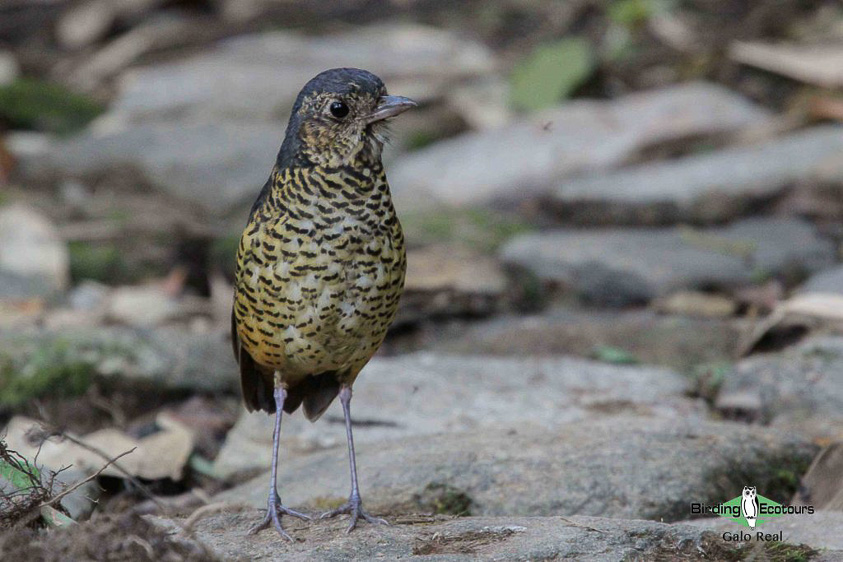
Day 18. Black Mud Pass and Leymebamba
We will leave before dawn to explore the high-elevation habitat of the Black Mud Pass. The main targets here are the endemic Russet-mantled Softtail, White-chinned Thistletail, the endemic Coppery Metaltail, Moustached Flowerpiercer, Sedge Wren, Many-striped Canastero, Blackish and Neblina Tapaculos, Grey-breasted Mountain Toucan, Superciliaried Hemispingus, White-banded Tyrannulet, White-throated Tyrannulet, Scarlet-bellied Mountain Tanager, Andean Guan, Black-capped Tyrannulet, Crowned Chat-Tyrant, Tufted Tit-Tyrant, and with luck Undulated Antpitta and Rusty-breasted Antpitta. In the afternoon we will check the Atuen road in search of Golden-headed Quetzal, Rainbow Starfrontlet, and with luck the majestic Andean Condor.
Overnight: La Casona de Leymebamba, Leymebamba
Day 19 Birding Balsas and transfer to Cajamarca
We will have a very early start to drive to Balsas in the Marañón valley. Here we will look for the endemic Yellow-faced Parrotlet, the endemic Grey-winged Inca Finch, the endemic Buff-bridled Inca Finch, the endemic Black-necked Woodpecker, and the endemic Chestnut-backed Thornbird. We might also find Bare-faced Ground Dove, Rufous-webbed Bush Tyrant, White-tailed Shrike-Tyrant and Brown-backed Chat-Tyrant.
Overnight: Wyndham Costa del Sol Cajamarca, Cajamarca
Day 20. Chonta Canyon and Cajamarca
Today we will explore the Chonta Canyon near Cajamarca, looking for the endemic Grey-bellied Comet, the endemic Black Metaltail, the endemic Rusty-crowned Tit-Spinetail, Peruvian Sierra Finch, Black-crested Tit-Tyrant, Black-crested Warbler, Giant Hummingbird, and White-winged Cinclodes. Later we will explore the Encañada area, looking for the endemic Rufous-eared Brushfinch, and, if time permits, Unicolored Tapaculo.
Overnight: Wyndham Costa del Sol Cajamarca, Cajamarca
Day 21. Flight back to Lima and connection with your international flight
You will be transferred to the Cajamarca airport to connect with your flight back to Lima and from there with your international departure.
Please note that the itinerary cannot be guaranteed as it is only a rough guide and can be changed (usually slightly) due to factors such as availability of accommodation, updated information on the state of accommodation, roads, or birding sites, the discretion of the guides and other factors. In addition, we sometimes have to use a different international guide from the one advertised due to tour scheduling.
Download ItineraryComprehensive Northern Peru Trip Report
10–30 MAY 2024
By Eduardo Ormaeche
DOWNLOAD TRIP REPORT
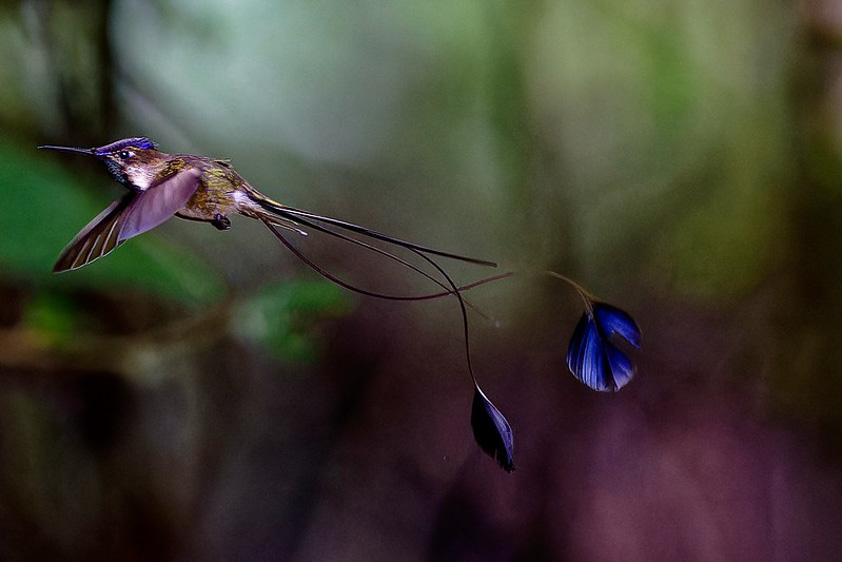
The exquisite Marvelous Spatuletail is one of the main targets on this spectacular tour (photo Dr Uwe Speck).
Overview
Our Comprehensive Northern Peru tour is an excellent overlanding birding adventure that covers five Peruvian states, with a focus on country endemics and regional specials shared with adjacent Ecuador and some neighboring countries. We started our trip by visiting the coast of Lima in search of Humboldt Current specials such as Inca Tern, Humboldt Penguin, Peruvian Pelican, Peruvian Booby, and Red-legged Cormorant. We then explored the desert and arid coastal valleys, where we had wonderful encounters with Rufescent Flycatcher, Pied-crested Tit-Tyrant, Parrot-billed and Drab Seedeaters, Pacific Pygmy Owl, West Peruvian Dove, Croaking Ground Dove, Coastal, Greyish and Thick-billed Miners, Amazilia Hummingbird, and Dark-faced Ground Tyrant. The coastal freshwater lagoons delivered other species, including Great Grebe and Many-colored Rush Tyrant.
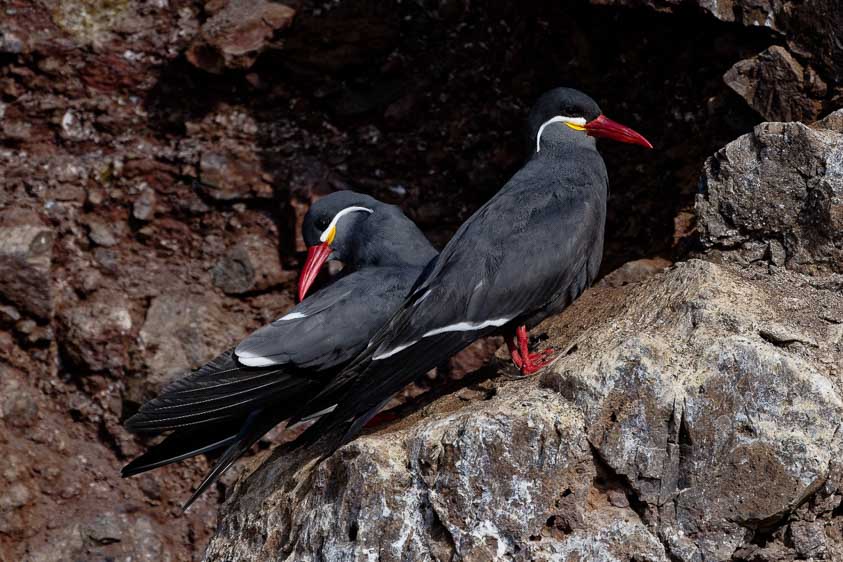
Inca Tern is one of the best-looking birds along the coast of Lima (photo Dr Uwe Speck).
After two introductory birding days south of Lima, we flew to Chiclayo, the capital of the Lambayeque State in northwest Peru, where we had several terrific birding days, finding many Tumbesian endemic species like Peruvian Plantcutter and the Critically Endangered White-winged Guan. The participants had the chance to enjoy tasty Peruvian cuisine at the local restaurants in the northwest – a non-birding highlight for many!
After cleaning up the Tumbesian zone, we crossed the Andes and descended into the Marañon Valley, where we enjoyed Maranon Crescentchest, Maranon and Chinchipe Spinetails, Spot-throated Hummingbird, Little Inca Finch, Speckle-breasted Wren, and Yellow-tailed Oriole.
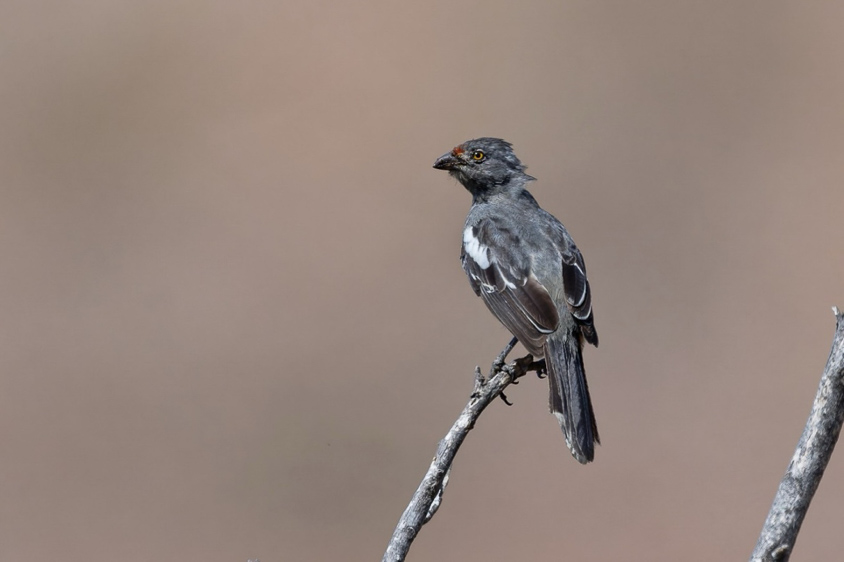
Peruvian Plantcutter – a Peruvian endemic (photo Dr Uwe Speck).
The lush tropical humid montane forest of the Amazonas State in Huembo and the famous Abra Patricia did not disappoint. Despite many rainy days, we managed great looks at the striking Marvelous Spatuletail – an endemic of the Utcubamba Valley, restricted to the Amazonas State! This bird is often regarded as the most spectacular hummingbird in the world and is a major drawcard of this tour. We also managed to feast our eyes with great views of the enigmatic Long-whiskered Owlet, Chestnut, Rusty-tinged and Ochre-fronted Antpittas, Lulu’s Tody-Flycatcher, Bar-winged Wood Wren, White-capped Tanager, Yellow-scarfed Tanager, Red-ruffed Fruitcrow, Crested Quetzal, Torrent Duck, and White-capped Dippers, among many others.
We continued visiting the upper tropical Amazon rainforest in Moyobamba and Tarapoto, which in recent years have emerged as key sites, together with the Amazonas State, providing us with the best bird feeding station route in the country. Moyobamba was superb, offering us the mega endemic Ash-throated Antwren, gorgeous Rufous-crested Coquette, Rufous-sided Crake, Pale-eyed Blackbird, Black-billed Seed Finch, Golden-collared Toucanet, and Cream-colored Woodpecker.The feeders above Tarapoto played host to Gould’s Jewelfront, the endemic Koepcke’s Hermit, and a lek of Golden-headed Manakins. For those on their first visit to the neotropics, seeing Hoatzin was a major highlight, and we had good views of a number of these prehistoric-looking birds in the tropical lowlands.
Before the end of our trip, we spent a few days exploring the upper Utcubamba Valley in the Amazonas State, where we saw Speckle-chested Piculet, Buff-bellied Tanager, and Golden-rumped Euphonia. We then embarked on one of the most scenic drives in Peru descending from the Abra Barro Negro Pass at 11,800 feet (3,600 meters) elevation down to the Marañon River in the Cajamarca State at 2,300 feet (700 meters). We were delighted to have pleasant weather to admire and enjoy the dramatic descent to the river, where we found species such as Russet-mantled Softtail, Coppery Metaltail, Andean Condor, Grey-breasted Mountain Toucan and localized endemics including Yellow-faced Parrotlet, Buff-bridled and Grey-winged Inca Finch, Maranon Pigeon, and Chestnut-backed Thornbird.
We concluded our adventure in Cajamarca, a historical city that dates back to the 16th century. This is the site where the Spaniards met the Inca civilization and changed the country’s history forever, establishing 300 years of colonial rule in Peru. It was, however, not all history in Cajamarca. Not far from the Otuzco ancient ruins, it is possible to see one of the rarest hummingbirds in the world, the endemic Grey-bellied Comet, and we had at least three different individuals of this mega endemic.
An immensely successful birding trip with long drives, several endemics, delectable cuisine, busy bird feeding stations, and daily early starts came to an end. We recorded 544 species of birds, perhaps slightly fewer than possible, but our group prioritized views of quality birds and good photos rather than achieving a high total. The hummingbirds deserve a special mention, as we saw no less than 56 species! We have included a detailed daily report as well as bird/mammal lists below and look forward to our next departure to this fantastic part of Peru.
Detailed Report
Day 1, 10th May 2024. Arrival in Lima
The group arrived in Lima and transferred to a comfortable hotel in Miraflores, where we spent the night.
Day 2, 11th May 2024. Southern coast of Lima
We left Lima early in the morning and transferred to Pucusana, an active fishing village and a great place to start birding the cold waters of the Pacific Ocean, which are strongly influenced by the Humboldt Current. For most people, Inca Tern was one of the birds of the day, and we enjoyed good numbers of both roosting and flying individuals.
At Pucusana, we saw Belcher’s Gull, Red-legged Cormorant, Peruvian Pelican, Peruvian Booby, Blackish Oystercatcher, and the charismatic Humboldt Penguin, which is the only breeding penguin species in the country. We took a short boat ride around the Pucusana Bay, and we added larger numbers of Inca Terns, Ruddy Turnstones, Peruvian Pelican, Peruvian Boobies, Blackish Oystercatcher, Neotropic and Red-legged Cormorants, and Kelp Gull. Unfortunately, we didn’t see any Blue-footed Boobies, and the number of pelicans was less than usual. We enjoyed South American Sea Lions among the fishing boats near the dock, however, the breeding colony was absent, probably due to the late El Niño.
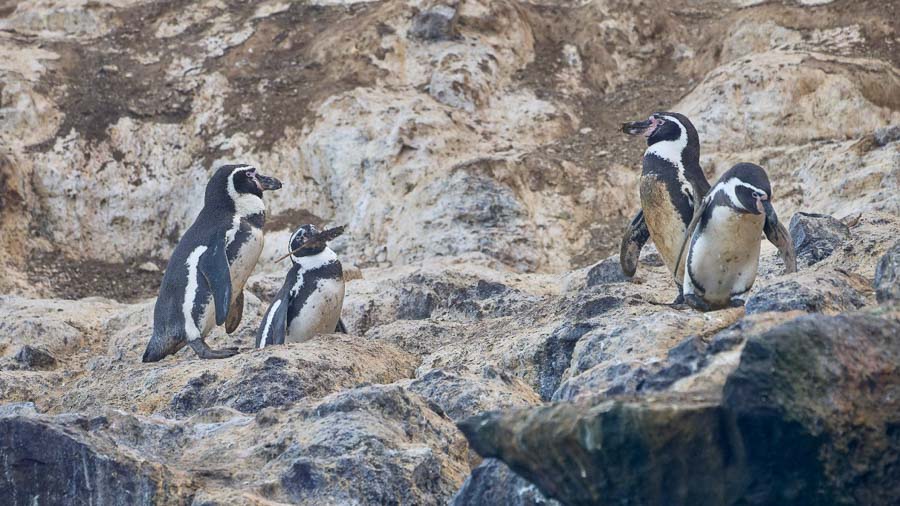
As the name suggests, Humboldt Penguin is another target of the cold waters of the Humboldt Current (photo Dr Uwe Speck).
We left Pucusana and headed towards the town of Chilca. On the way, we explored the small wetlands along the shores of the Playa Yaya, where we were hoping for Peruvian Thick-knee and Peruvian Martin, both seen earlier this year on a Birding Ecotours day tour. Sadly, none were around, however, we entertained ourselves with great views of common species such as Cinnamon Teal, White-cheeked Pintail, Grey-headed and Franklin’s Gulls, Puna Ibis, and Black-necked Stilt. We even saw some of the last-remaining shorebirds before their winter departure, such as Kildeer, Snowy Plover, Wilson’s Phalarope, Hudsonian Whimbrel, Marbled Godwit, Willet, Lesser and Greater Yellowlegs, Stilt Sandpiper, and Pectoral Sandpiper. While enjoying Black Skimmers, we spotted Peruvian Pipit, Least Seedsnipe, and Coastal Miner.
The morning was ending, and we continued south to our next location – the Puerto Viejo wetlands, where we planned to have our picnic lunch. At the entrance to the wetland, I was surprised to see it was all fenced off. Finally, the land under extreme pressure from the adjacent chicken farms and building resorts has been purchased and no longer allows visitors. I knew this would eventually happen, but it was still disheartening to see the loss of habitat and the efforts of some Peruvian conservationists who tried to preserve the wetland, to no avail. We were granted access to the wetlands after a brief talk with the new landowner. We saw Many-colored Rush Tyrant, Wren-like Rushbird, Grassland Yellow Finch, Vermilion Flycatcher, and Croaking Ground Dove. We left the wetlands here for what could be the last time and headed to the desert and dry valleys around Asia.
We had a productive afternoon exploring the inland arid valleys where we found Pacific Pygmy Owl, Pied-crested Tit-Tyrant, Parrot-billed and Drab Seedeaters, Plumbeous Rail, Rufescent Flycatcher, Amazilia Hummingbird, Pacific Parrotlets (introduced population), Collared Warbling Finch, and Short-tailed Field Tyrant.Sadly, we missed the Tschudi’s Nightjar, which we have often seen here before on our tours. We returned to the hotel and enjoyed a tasty dinner in an Argentine restaurant where we found a solo Peruvian Thick-knee in the parking lot.
Day 3, 12th May 2024. Lomas de Asia and flight to Chiclayo
Today, we explored the Lomas de Asia, which offers chances for some of the notable endemics also found at Lomas de Lachay but with better opportunities for some of the rare endemics, including Raimondi’s Yellow Finch, Thick-billed Miner and Cactus Canastero. We arrived at the reserve and found Band-tailed Sierra Finch, Southern Beardless Tyrannulet, and Greyish Miner at our breakfast stop. We heard Thick-billed Miner, but despite our best efforts, it would remain unseen, for now. Once we ended our breakfast, we started walking to the “Canastero Ridge.”
This walk can be a demanding hike for some folks. However, as soon as we started hiking, we saw Burrowing Owl and a Variable Hawk (the red-backed form) with a Montane Vizcacha in its talons. Later along the walk, we got onto at least five Thick-billed Miners,and those who conquered the top of the cacti ridge managed to see Cactus Canastero. We also enjoyed a few Raimondi’s Yellow Finches drinking from a water tank. With all of the endemic targets in the pocket, we started our return to the car. We were hoping for an Andean Fox or Pampas Cat along the way, but no luck this time.
We left and were transferred to the airport for our flight to Chiclayo, where we landed in the afternoon and made our way to our lovely hotel for the night.
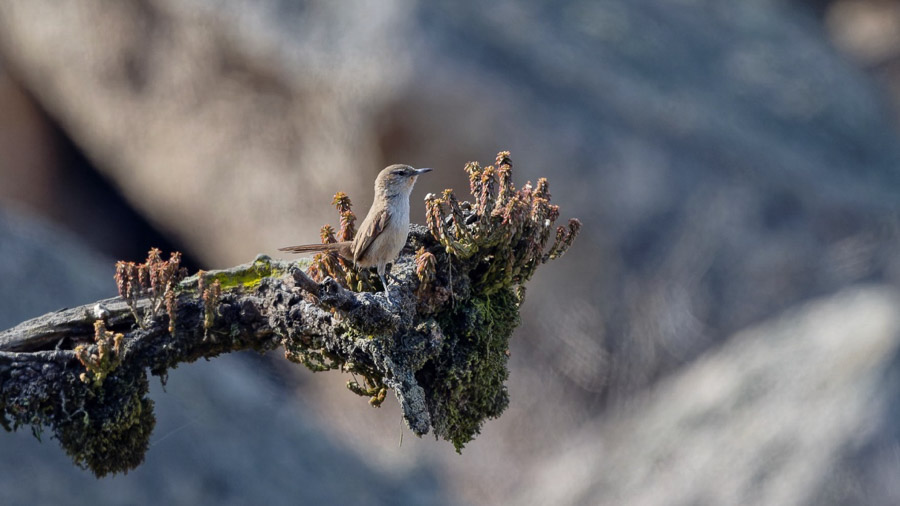
The endemic Cactus Canastero in Lomas de Asia (photo Dr Uwe Speck).
Day 4, 13th May 2024. Bosque de Pomac and transfer to Olmos
We left Chiclayo and headed towards the Bosque de Pomac History Sanctuary to explore a large tract of Prosopis pallida, locally known as Algarrobal woodland. This sanctuary is one of the only areas in northwest Peru where this habitat occurs, and it harbors several exciting species, including Peruvian Plantcutter and Rufous Flycatcher. We started the morning with our mandatory stimulants – fresh hot coffee, English breakfast tea, Monster energy drink or hot chocolate – the choice is yours! While enjoying a quick field breakfast, we were distracted by an active bird party containing Fulvous-crowned Pygmy Tyrant, Grey-and-white Tyrannulet, White-browed Gnatcatcher, Pacific Hornero, Long-tailed Mockingbird, Collared Antshrike, and Golden-olive Woodpecker.
We started walking along trails, and we found Chinchipe Spinetail, Amazilia Hummingbird, Fasciated Wren, Scarlet-backed Woodpecker, Streak-headed Woodcreeper, Pacific Parrotlet (wild population), White-edged Oriole, and the handsome Tumbes Tyrant (Tumbes Chat-Tyrant). We were also treated to views of Guayaquil Squirrel and the first of the endemics: Rufous Flycatcher.
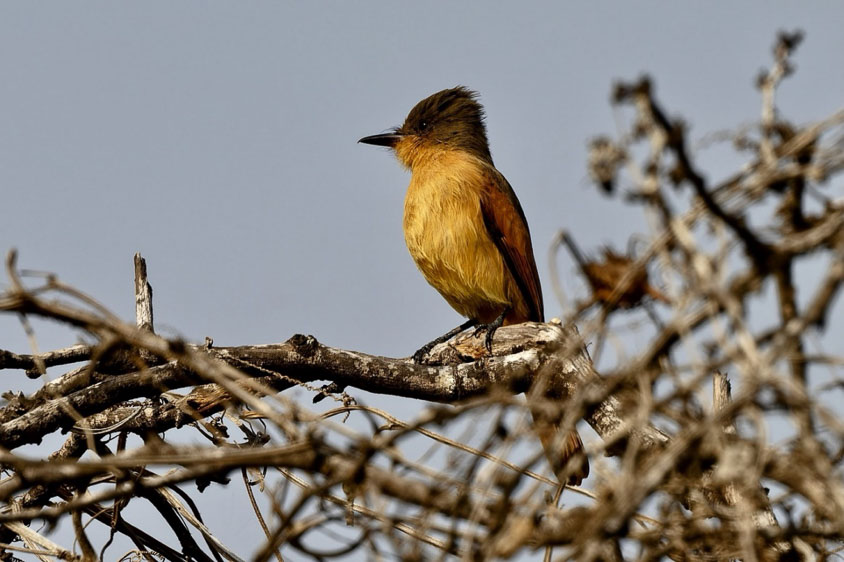
Rufous Flycatcher, yet another endemic (photo Dr Uwe Speck).
We visited other areas in the sanctuary, where we finally had good views of Peruvian Plantcutter (male and female) and several Tumbes Swallows. We had to settle with just a glimpse of White-tailed Jays, which were scarce on this trip. We left Bosque de Pomac and added a few extra birds driving through fields and villages, such as Grey-breasted Martin, Pearl Kite, Harris’s Hawk, Black and Turkey Vultures, Saffron Finch, Crested Caracara, and Western Cattle Egret.
Due to new road constructions, we had to return to Chiclayo by driving through the roughest suburbs of this bustling town. However, we were out of the hectic city soon and enjoyed another great meal where participants could enjoy the northern cuisine – fresh flounder seafood dishes.
We headed to Olmos during the heat of midday, not before adding Ringed Kingfisher and Least Grebe to the list. We arrived in Olmos in the afternoon and had a rest break for the next day’s predawn start.
Day 5, 14th May 2024. Quebrada Frejolillo
We left Olmos after a 4 am breakfast and headed to Quebrada Frejolillo, the site where White-winged Guan was rediscovered in 1977. During our drive, some of us saw American Barn Owl as well as Sechura Fox and Stripe-nosed Hog Skunk.
We arrived at dawn, and after checking in with the members of the community to organize our visit permits, we started our morning exploring the foothills of the dry Tumbesian zone. To our delight, the first species we saw was the Critically Endangered White-winged Guan and not just one but 20 individuals! I have visited this place for over 20 years and have never seen this many individuals close to the village. Later, we saw two more individuals who posed for a photo.
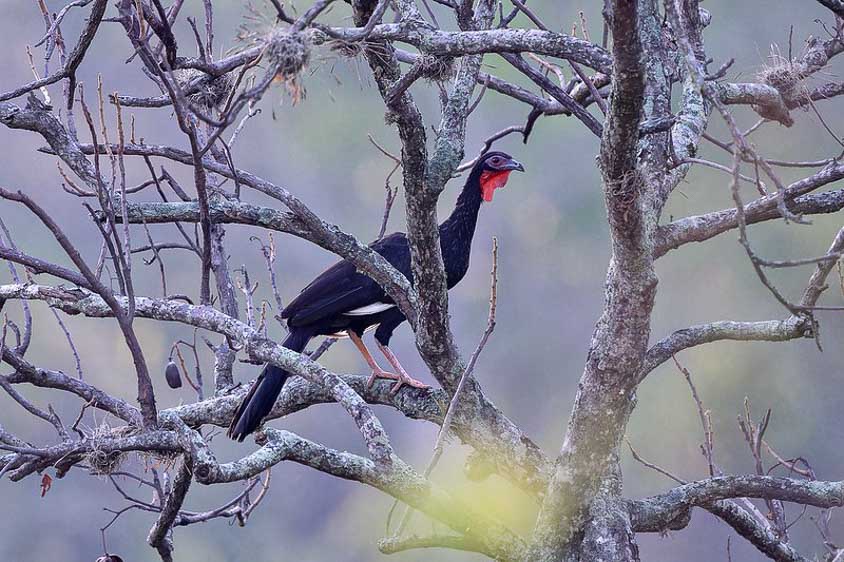
The critically endangered White-winged Guan was rediscovered in 1977 at Quebrada Frejolillo (photo Dr Uwe Speck).
We heard Pale-browed Tinamou, which generally prefers to stay along the dry riverbed and while walking around, we found Whooping Motmot, Ecuadorian Trogon, Tropical Parula, Red-masked Parakeet, Pacific Elaenia, Tumbes Pewee, Slaty Becard (a good record for the area), White-headed Brushfinch, Hepatic Tanager, Thick-billed Euphonia, Bay-crowned Brushfinch, Baird’s Flycatcher, Pacific Pygmy Owl, three King Vultures, Short-tailed Swift (the occipitalis race, sometimes considered to be a separate species: Tumbes Swift), Chestnut-collared Swift, Harris’s Hawk, Black-chested Buzzard-Eagle, Plumbeous-backed Thrush, Golden Grosbeak, and Short-tailed Woodstar.
On the way out, while driving the mid-elevations and lower sections, we made strategic stops to look for Cinereous Finch, Tumbes Hummingbird, and Tumbes Sparrow. We saw all exceedingly well, not before we found a large flock of at least 30 Peruvian Thick-knees roosting during the day. Our time at Quebrada Frejolillo was excellent and made our early start all worth it. We retreated south to spend the afternoon at Los Faiques Lodge, where we refreshed ourselves with a hot shower, ordered drinks, and walked around the woodland property looking for birds. We had another sighting of Plumbeous-backed Thrush, and some enjoyed the impressive botanical collection at the lodge.
After a tasty dinner, we secured great views of West Peruvian Screech Owl, and we found a Black-eared Opossum. We retreated to the comfort of our rooms in preparation for the following day.
Day 6, 15th May 2024. Abra Porculla and transfer to Jaen
After a much-needed cup of excellent quality coffee at 4.30 am, we were ready to face the day. We left Salas before dawn and headed to Abra Porculla (the lowest mountain pass in the Peruvian Andes at a maximum of 6,600 feet (2,010 meters) elevation). The habitat here consists of pockets of vegetation on the mountain slopes where some west slope species, like Fasciated Wren, occur at their upper elevational limit. Similarly, some east slope species occur here, that do not cross the west slope of the Andes, such as Silver-backed Tanager, Slate-throated Whitestart, Rufous-chested Tanager. Other specials, including Three-banded Warbler, Chapman’s Antshrike, Rufous-winged Tyrannulet, Tumbesian Tyrannulet, Line-cheeked Spinetail, Black-cowled Saltator, Yellow-tailed Oriole, Great Thrush, and Sparkling Violetear also occur here and were seen very well. The weather was great! The air was cool, and conditions were overcast, which these birds seemed to favor. We were hoping for Grey-and-gold Warbler and Ecuadorian Piculet, but neither cooperated today. We soaked up a fantastic encounter with a Fawn-breasted Tanager and then tried for Chestnut-crowned Antpitta, which we taped out and eventually had satisfactory views of. We also had a Black-and-white Seedeater, Dull-colored Grassquit, Pacific Pygmy Owl and Sooty-crowned Flycatcher, and this was just during the first couple of hours!
We tried for Elegant Crescentchest and were rewarded with splendid views of a pair of these incredible birds! We tried hard for the two foliage-gleaners, which were vocal and ended with reasonably good looks at Henna-hooded Foliage-gleaner and an excellent view of Rufous-necked Foliage-gleaner. Piura Chat-Tyrant was shy and showed well, but only briefly. Ash-breasted Sierra Finch was seen in the drier parts, and Azara’s Spinetail performed well on the west slope of the Andes foothills. We continued our journey, travelling through Huancabamba and Chamaya and crossed the states of Piura and Cajamarca on our way to the Cajamarca lowlands, near the border with Ecuador.
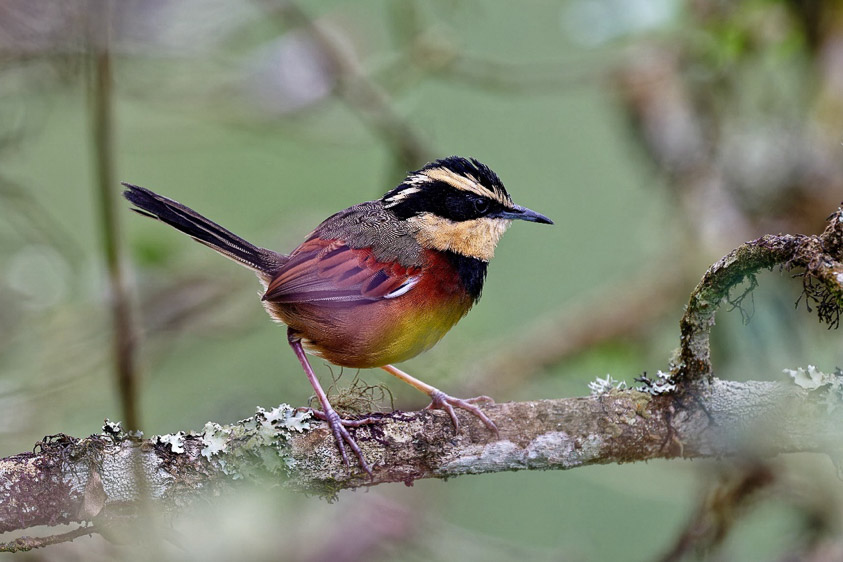
Elegant Crescentchest at Abra Porculla (photo Dr Uwe Speck).
During our descent from the Andes, we saw our first Bare-faced Ground Dove, and along the rice fields of the Chamaya River, we had great views of Comb Duck and Scrub Blackbird. We then arrived at our comfortable hotel in Jaen and had the last hours of the afternoon free to shower and relax until dinnertime.
Day 7, 16th May 2024. Bosque de Yanahuanca and transfer to Huembo
We had another early start today to explore Bosque de Yanahuanca Private Reserve, a relatively new addition to our itinerary that offers opportunities to see all of the Marañon specials close to Jaen. We arrived early in the morning and got our first Striped Cuckoo and Chinchipe Spinetail, followed by Yellow-tailed Oriole, Purple-throated Euphonia, Cordilleran Parakeet, Blue Ground Dove, and Andean Emerald. We then searched for the endemic and localized Little Inca Finch, which we found in a pristine section of xerophytic habitat.
We continued birding, finding Red Pileated Finch, Inca Jay, the endemic Spot-throated Hummingbird, and Speckle-breasted Wren (nominate race). Vermillion Flycatcher, Black-and-white Becard, Northern Slaty Antshrike (leucogaster race, sometimes treated as Marañon Antshrike), Streaked Saltator, Tropical Gnatcatcher (maior race), Chestnut-throated Seedeater, Brown-crested Flycatcher, Social Flycatcher, Rufous-fronted Thornbird, and the handsome Maranon Crescentchest all showed well. We explored the humid gulleys and managed views of a secretive and shy Maranon Spinetail. We heard Tataupa Tinamou distantly and saw White-lined Tanager, Golden Grosbeak, and Common Tody-Flycatcher.
We crossed the Marañon River in Corral Quemado and entered the state of Amazonas. Here, we followed the course of the Utcubamba River towards the semi-humid montane forest in the Bongara province to stay at the Huembo Reserve, the site for Marvelous Spatuletail. We arrived late in the afternoon, but we still managed to see Little and White-bellied Woodstars, Lesser Violetear, White-bellied Hummingbird, Andean Emerald, Chestnut-breasted Coronet, and Green-tailed Trainbearer.
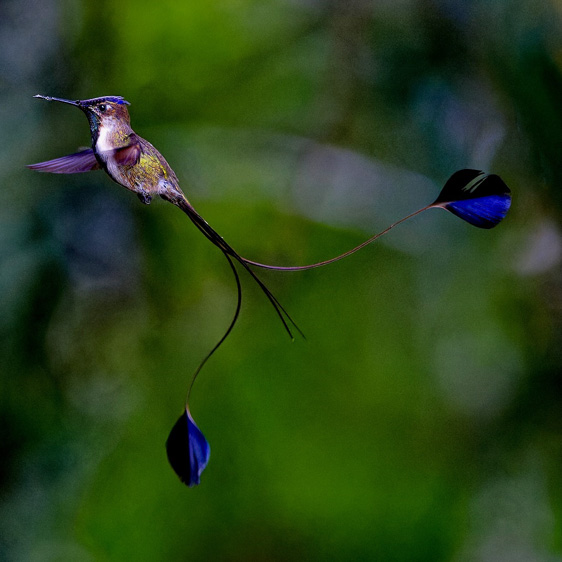
Marvelous Spatuletail put on a show for us! (photo Dr Uwe Speck).
Day 8, 17th May 2024. Huembo and transfer to Abra Patricia
It was lovely to sleep in until 06.00 am and to get a proper breakfast at 06.30 am after several days of predawn starts and covering long distances. Everyone greatly appreciated the relatively relaxed morning, and it helped us recover slightly in preparation for another busy day of birding. We could afford this luxury as our main target, Marvelous Spatuletail, is best seen visiting the feeders here. As soon as we finished breakfast, we walked down to the feeders of this lovely little reserve and sat down to wait for this magnificent bird. We saw Bronzy Inca, Sparkling and Lesser Violetears, Violet-fronted Brilliant, Purple-throated Sunangel, White-bellied Hummingbird, White-bellied Woodstar, and Chestnut-breasted Coronet. We waited for some time until the spatuletail decided to show up, as other more aggressive species chased it off. We managed to see this global mega very well and even walked away with satisfactory photos. Other birds in the area included Variable Antshrike, Yellow-breasted Brushfinch, Inca Jay, Streaked Xenops, Sierran Elaenia, Brown-capped Vireo, Silver-backed Tanager, White-crowned Tapaculo, and Buff-browed Foliage-gleaner – the latter two remained heard only. We also had large flocks of Mitred Parakeet flying over the reserve.
We left the reserve and headed to Owlet Lodge in the Abra Patricia Mountains. Due to the exceptional avian diversity, the humid montane forest here has long been on the radars of visiting birders. We arrived at the lodge and spent the day birding the lodge grounds and enjoying the hummingbird feeders. The feeders were busy, and we saw Emerald-bellied Puffleg, Collared Inca, Long-tailed Sylph, Speckled Hummingbird, and Fawn-breasted Brilliant – all new additions to the trip list. The day was quiet for a while, and we heard several birds, including Rufous-vented Tapaculo, Russet-crowned Warbler, Green-and-black Fruiteater, and Rufous Spinetail.Later, on the way down to the gate, we heard the distant call of a flock of White-capped Tanagers. After some playback, we had walk-away views of these stunning birds. Immediately after the tanagers, our first mixed species flock passed by the lodge, producing Yellow-scarfed Tanager, Lacrimose Mountain Tanager, Grass-green Tanager, Spectacled Whitestart, Blue-capped Tanager, Olivaceous Siskin, Hooded Mountain Tanager,and Montane Woodcreeper. We concluded the day with a Bat Falcon perched in the lodge grounds.
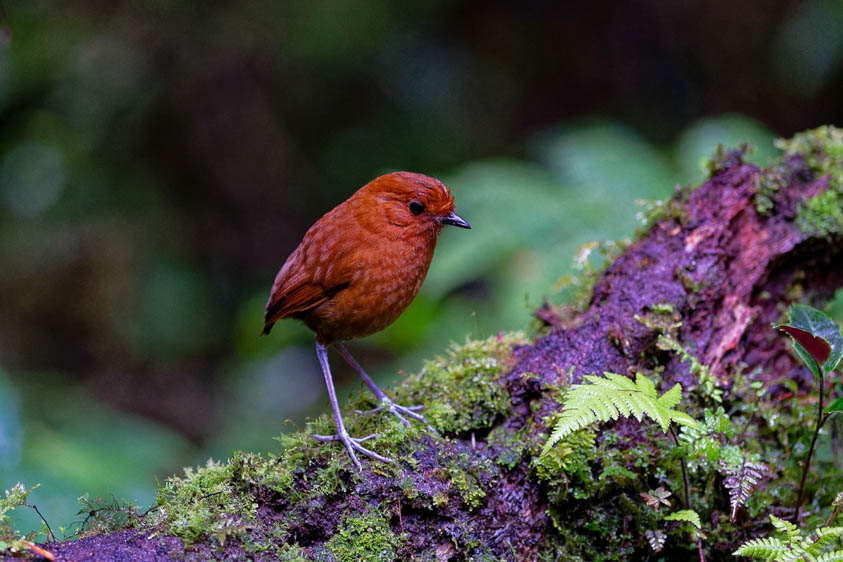
Chestnut Antpitta is always a treat to see (photo Dr Uwe Speck)!
Day 09, 18th May 2024. Owlet Lodge
We started the day with incredible views of the endemic Chestnut Antpitta at theworm feeding station. We then spent an hour birding along the road out of the lodge, looking for Lulu’s Tody-Flycatcher, which is no longer found in the lodge gardens and seems to prefer disturbed habitat with bamboo scrub, but unfortunately drew a blank, for now. We, however, saw Streak-headed Antbird, Green-fronted Lancebill, Flame-faced and Blue-and-black Tanagers, Olive-backed Woodcreeper, and Silver-backed Tanager. We returned to the lodge quickly to be the first group attending the new Rufous-breasted Wood Quail feeding station, a new birding facility for birders and photographers. We had a successful session with a covey of quails and both Chestnut-capped Brushfinch and White-throated Quail-Dove.
We continued birding the trails, but unfortunately, there was little activity. We went up to the canopy platform and enjoyed good views of Sword-billed Hummingbird, Peruvian Tyrannulet, Beryl-spangled Tanager, and Ruddy Pigeon. We heard the coveted White-faced Nunbird distantly, and despite trying to lure the bird in closer, our efforts were unsuccessful. A bustling mixed species flock allowed for views of Pearled Treerunner, Streaked Tuftedcheek, Montane Woodcreeper, Blue-and-black Tanager, White-sided Flowerpiercer, Russet-crowned Warbler, Spectacled Whitestart, Drab Hemispingus, and Pale-edge Flycatcher.
With an overcast sky and a drizzle, we decided to walk down the trail searching for Long-whiskered Owlet. We did not bird too much on the way down except in a well-preserved patch of bamboo where we saw the endemic Lulu’s Tody-Flycatcher. Despite the excellent condition of the trail, we still had to walk some distance and cross a few fast-flowing streams. However, our group was determined to give it their best, and we were rewarded with views of this most-wanted and poorly known owlet. On the way back, we managed to get a glimpse of the endemic Andean Night Monkey. There was no loop, so we had to return the same way; predictably, the walk was far more manageable with Long-whiskered Owlet in the bag.
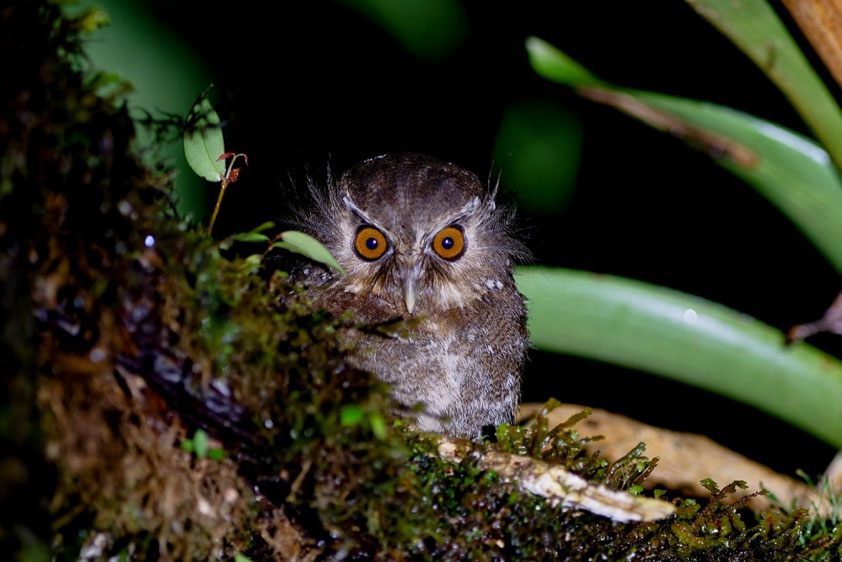
Long-whiskered Owlet at Abra Patricia (photo Dr Uwe Speck).
Day 10, 19th May 2024. Owlet Lodge and Alto Nieva
Another predawn cup of coffee, and we were ready to start our day looking for the endemic Ochre-fronted Antpitta. Within our first hour of birding, we had a male along one of the trails, success! Later, we moved on to a feeding station where the lodge feeds the endemic Rusty-tinged Antpitta, but it wasn’t to be today. We explored the trail and had Uniform Antshrike, Russet-crowned Warbler, Inca Flycatcher, Green-and-black Fruiteater, Mottle-cheeked Tyrannulet, White-collared Jay, Olive-backed Woodcreeper, Masked Trogon, Spotted Barbtail, Rufous Spinetail, and Rufous-vented Tapaculo.
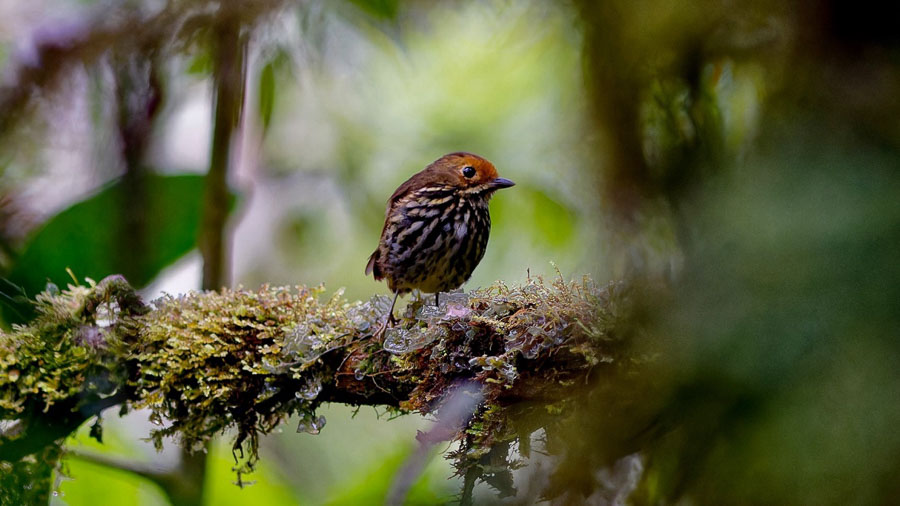
Ochre-fronted Antpitta found at Owlet Lodge (photo Dr Uwe Speck).
One of our participants photographed a Crimson-bellied Woodpecker, which sadly was not seen again during the tour. Before we returned to the lodge, I spotted a Chestnut-crested Cotinga, which everyone enjoyed.
Back at the lodge, we saw many of the same hummingbirds as on the previous day at the feeders, plus a Black Agouti who came to feed on the bananas the lodge staff left for it. We explored the Alto Nieva area out from the lodge and saw a pair of Torrent Ducks along the river and a few White-capped Dippers. We returned to the lodge for lunch and planned to return in the afternoon.
In the afternoon, the main target was the localized Royal Sunangel, which, after some time, we managed to see well. We tried for the localized Bar-winged Wood Wren without success and added Golden-eyed Flowerpiercer, Peruvian Racket-tail, Rufous-tailed Tyrant, Metallic-green Tanager, and Yellow-throated Tanager.On the way back to the lodge, we lucked onto an unusual sighting of a flushed Hooded Tinamou flying across the road with its typical clumsy wingbeat.
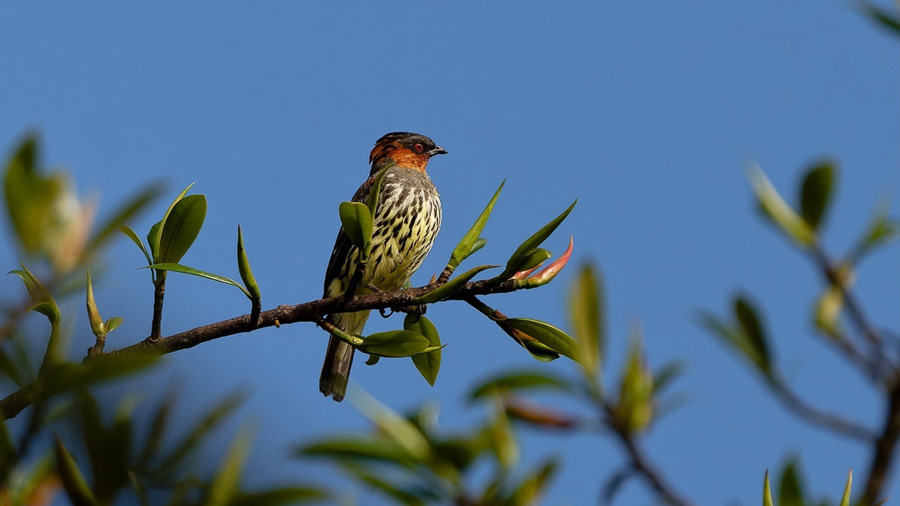
The striking Chestnut-crested Cotinga at Owlet Lodge (photo Dr Uwe Speck).
Day 11, 20th May 2024. Owlet Lodge and transfer to Moyobamba
On our last morning at Owlet Lodge, we decided to try again for Rusty-tinged Antpitta at the feeding station. However, we ended with merely a glimpse of it coming to get the worm and disappearing in a fraction of a second. We, however, encountered Striped Treehunter, Barred Becard, Bluish Flowerpiercer, Oleaginous Hemispingus, Cinnamon Flycatcher, Grass-green Tanager, and Grey-breasted Wood Wren.
We stopped at Nieva, where we got a glimpse of Bar-winged Wood Wren and a few great sightings, including Red-ruffed Fruitcrow and a nice Crested Quetzal.
We left Nieva with heavy rain and headed towards the tropical lowlands of the San Martin State, making a stop at the Yacumama restaurant and recreational center where we managed to add our first set of lowland species such as Boat-billed Flycatcher, Crested and Russet-backed Oropendolas, Yellow-rumped Cacique, Thrush-like Wren, White-lored Euphonia (also known as Golden-bellied Euphonia), Ringed Kingfisher, Amazon Kingfisher, Striated Heron, Black Caracara, Black-fronted Nunbird, Cobalt-winged Parakeet, Chestnut-eared Aracari, Green-backed Trogon, Amazonian Barred Woodcreeper, White-winged Becard, Blue Ground Dove, White-tipped Dove, and of course one of our main targets, the Point-tailed Palmcreeper, which we saw remarkably well.
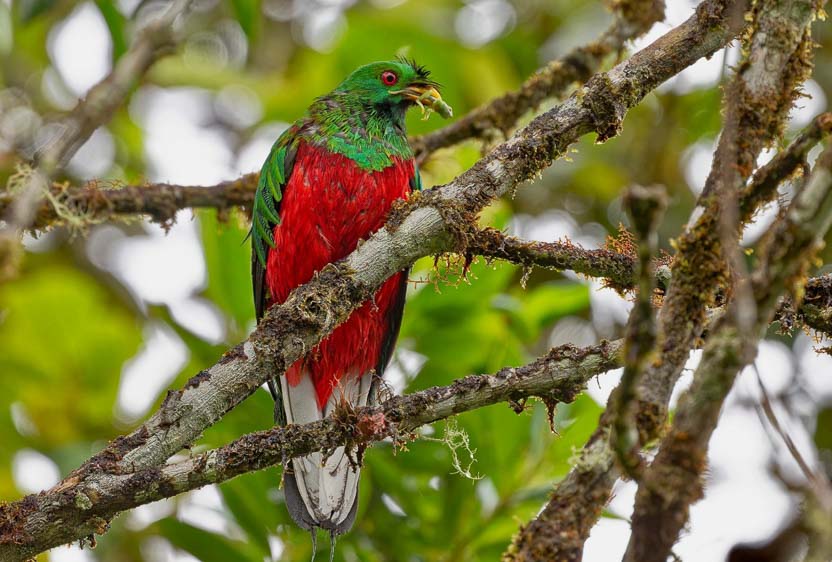
Crested Quetzal with protein supply at Nieva (photo Dr Uwe Speck).
We continued our drive towards Moyobamba and to the Wakanki Lodge. We arrived at the lodge, and immediately after check-in, we saw the striking Rufous-crested Coquette, another of the group’s most-requested birds. We managed to get superb views of a male in the bushes in front of the rooms.
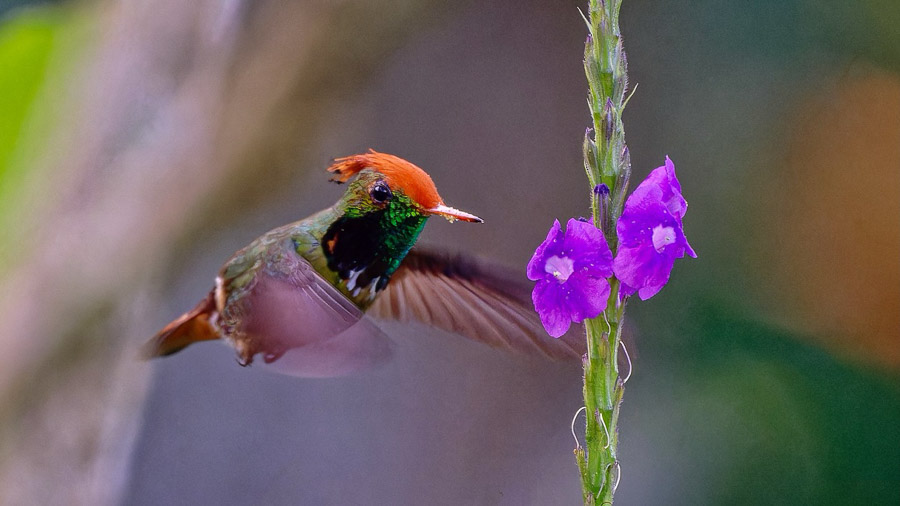
Rufous-crested Coquette at its best (photo Dr Uwe Speck).
Day 12, 21st May 2024. Moyobamba foothills
Today we started after breakfast and drove north of Moyobamba to reach our target elevation of about 4,600 feet meters (1,400). We looked for the endemic Masked Fruiteater, which, unfortunately, was not around that morning. However, we saw other exciting species, such as the mega endemic Ash-throated Antwren, an Endangered endemic of the San Martin State. Other birds included Blackish Antbird, fabulous views of Wing-barred Piprites, White-crowned Manakin, Orange-eared Tanager, Blue-winged Mountain Tanager, Masked Tanager, Black-faced Dacnis, Purple Honeycreeper, Green Honeycreeper, Blue Dacnis, Lineated Woodpecker, Olivaceous Woodcreeper, Forest Elaenia, Grey-capped Flycatcher, Swallow Tanager, and Ruddy Pigeon. We heard Western Fire-eye,but it didn’t cooperate for views. We also heard Collared Forest Falcon and saw Swallow-tailed Kite and Plumbeous Kite.I managed to get a glimpse of the elusive Chestnut-crowned Gnateater, but unfortunately, the group missed it. We returned to Wakanki Lodge and visited the Finca San Camilo owned by Jose Altamarino (former manager of Owlet Lodge), where we got an exquisite gourmet coffee and saw Paradise Tanager, Blue Dacnis, Black-faced Dacnis, and Lafresnaye’s Piculet.
Then, in the afternoon, we spent a couple of hours at the hummingbird feeding station enjoying views of Black-throated Mango, Grey-breasted Sabrewing, Golden-tailed Sapphire, Great-billed and Black-throated Hermit, Rufous-crested Coquette (including a female), Blue-tailed Emerald, White-necked Jacobin, Fork-tailed Woodnymph, Sapphire-spangled Emerald, and some participants saw White-chinned Sapphire.
Day 13, 22nd May 2024. Morro de Calzada and transfer to Tarapoto
Today, we had another early start to explore the Morro de Calzada south of Moyobamba. This time, we had the chance to visit a new private reserve that has a feeding station for Rufous-sided Crake. I have to say that watching “Tito and Tita” feeding out in the open of the swampy pond was a really unexpected treat for both me and the participants.
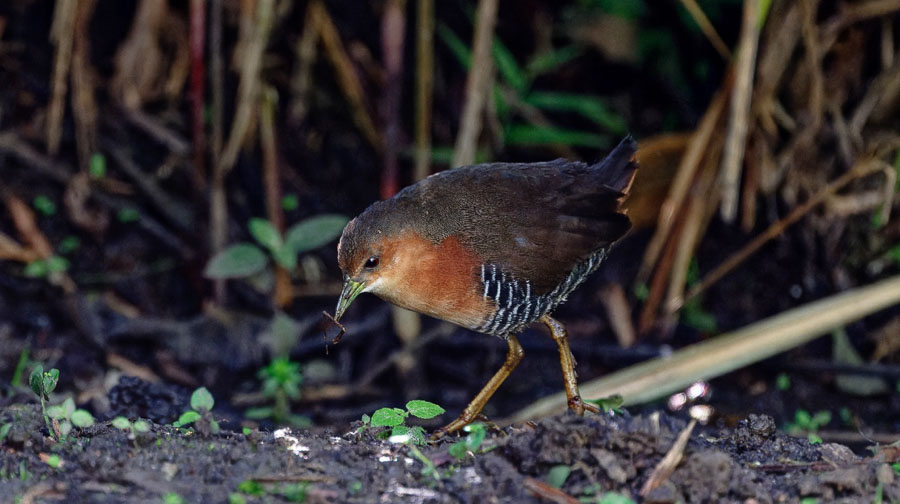
Rufous-sided Crake put on an excellent performance (photo Dr Uwe Speck).
The reserve also offered a number of other good birds like Golden-collared Toucanet, Channel-billed Toucan (heard), Cream-colored Woodpecker, Swallow Tanager, Peruvian Warbling Antbird, Northern Chestnut-tailed Antbird (also known as Zimmer’s Antbird), Red-stained Woodpecker, Short-tailed Pygmy Tyrant, Yellow-bellied Tanager, Yellow-crowned Tyrannulet, Grey-crowned Flatbill, Rufous-crested Coquette, White-vented Euphonia, the endemic Huallaga Tanager, Paradise Tanager, White-winged Tanager, Bluish-fronted Jacamar, Masked Tityra, Yellow-tufted Woodpecker, and others. We tried for the recently described Painted Manakin, but despite our efforts, it didn’t come out into the open.
We left Moyobamba and headed north to Tarapoto. Along the route, we stopped at the famous Quisquirumi bridge, where we got good views of dozens of monotypic Oilbirds, flocks of White-eyed Parakeets and a single Short-tailed Hawk. We arrived at our hotel in Tarapoto and enjoyed a few hours off before heading to a lovely pasta restaurant in town.
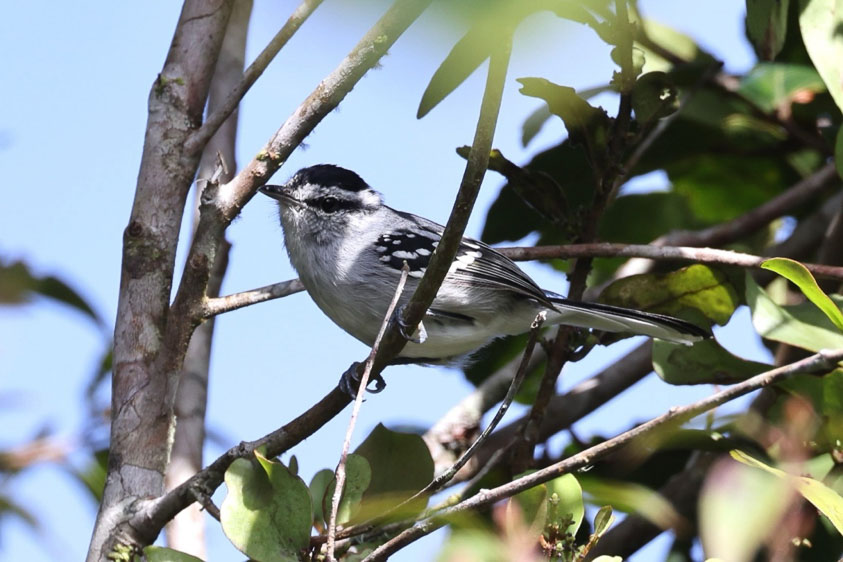
The mega endemic Ash-throated Antwren was seen nicely on our tour (photo Charles Davies).
Day 14, 23rd May 2024. Aconavit Reserve
We scheduled an entire morning at the Aconavit feeding station to look for lowland species and interesting foothill hummingbirds. This place is also known as Koepcke’s Hermit Reserve as the endemic Koepcke’s Hermit is commonly seen at the reserve’s feeders. We had a delightful session with hummingbirds, including Gould’s Jewelfront, Blue-fronted Lancebill, Pale-tailed Barbthroat, Golden-tailed Sapphire, Grey-breasted Sabrewing, Sapphire-spangled Emerald, Fork-tailed Woodnymph, and several Koepcke’s Hermits.
From a vantage point in the reserve, we got views of White-tipped, Short-tailed and White-collared Swifts, Swallow-tailed Kite and our first Double-toothed Kite, which showed well for everyone. We also connected with Paradise Tanager, Violaceous Jay, Magpie Tanager, Common Tody-Flycatcher, and Chestnut-bellied Seed Finch – all showing well.
We walked along a steep trail into the forest, and after a few minutes, we arrived at the Golden-headed Manakin lek, where we got great views of a few males displaying. En route, we heard several forest birds such Black-faced Antthrush, Plain-winged and Mouse-colored Antshrikes, Southern Nightingale-Wren, Ochre-throated Foliage-gleaner, Coraya Wren, White-flanked Antwren, and Yellow-margined Flatbill;all these remained as heard only species.
We left the reserve and made our way back to Tarapoto, where we had lunch at a local restaurant and enjoyed traditional Amazon cuisine. Our plan for the afternoon was to focus on exploring the lower parts of the road to Aconavit. However, our plans were unfortunately cut short due to ongoing road construction.
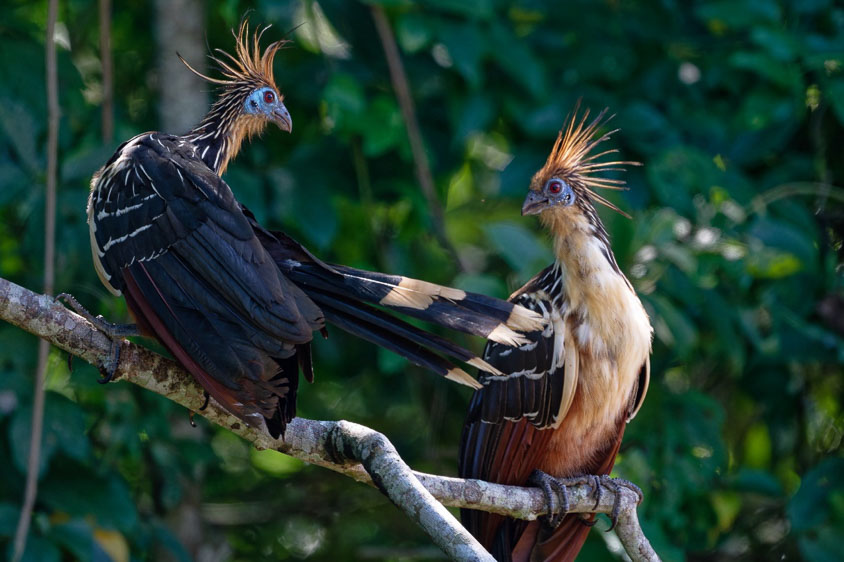
Hoatzin in the Huallaga River(photo Dr Uwe Speck).
Day 15, 24th May 2024. Tarapoto and return to Moyobamba
After many days of having predawn breakfasts, we had a welcome break and decided to get breakfast at the hotel at about 6.30 am. This break was strategic as we had a few long days to come. We left Tarapoto and headed to the Huallaga River, where our goal was to find the widespread and monotypic Hoatzin, a species high on the wish list of any birder visiting the neotropics for the first time. We did not have to search for long, and soon had several individuals at this site. Also seen here were White-banded and White-winged Swallows, Southern Rough-winged Swallow, Swallow-winged Puffbird, Yellow-tufted Woodpecker, Yellow-browed Sparrow, Dusky-headed Parakeet, Short-crested Flycatcher, Cobalt-winged Parakeet, and Yellow-headed Caracara.We did not explore thedry portions of the Huallaga River this time, instead, we returned to Moyobamba in time to explore the rice fields of Posic, south of Moyobamba.
The afternoon was excellent with views of Spotted Rail, Red-capped Cardinal, Spot-breasted and Little Woodpeckers, Pale-legged Hornero, Oriole Blackbird, Orange-backed Troupial, Little Cuckoo (which was seen briefly), Bluish-grey Saltator, Purple Gallinule, Black-capped Donacobius, Striated Heron, Ringed Kingfisher and of course our two targets Black-billed Seed Finch and Pale-eyed Blackbird.
Day 16, 25th May 2024. Reserva Arena Blanca and transfer to Huembo
We had a predawn start so that we could be at the Arena Blanca Reserve before 06.30 am to try for Little and Cinereous Tinamous and Rufous-breasted Wood Quail that had been visiting the feeding station. The landowner informed us that the Little Tinamou had not been coming for several days, but the other two were attending normally. The rain had set in again, so we started with the hide, followed by breakfast, hummingbird feeders, and the gardens, which sounded like a plan considering the inclement weather.
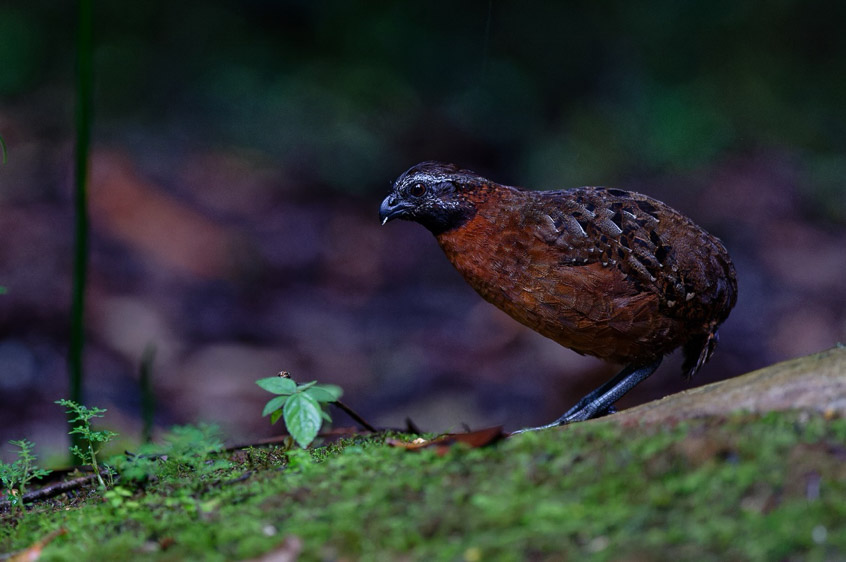
The incredibly cute Rufous-breasted Wood Quail (photo Dr Uwe Speck).
A covey of Rufous-breasted Wood Quails was the first to show – this was our second encounter with this species after our first experience at Owlet Lodge. Then we were thrilled to see a Cinereous Tinamou coming with a youngster to the feeder. Our adrenaline had barely settled before the Little Tinamou showed up, too, with a chick! What an unforgettable experience! We waited for some usual suspects here, such as Grey-cowled Wood Rail, Ruddy Quail-Dove and Orange-billed Sparrow, but they were not around this morning. We then got our breakfast and enjoyed birds at the feeders.
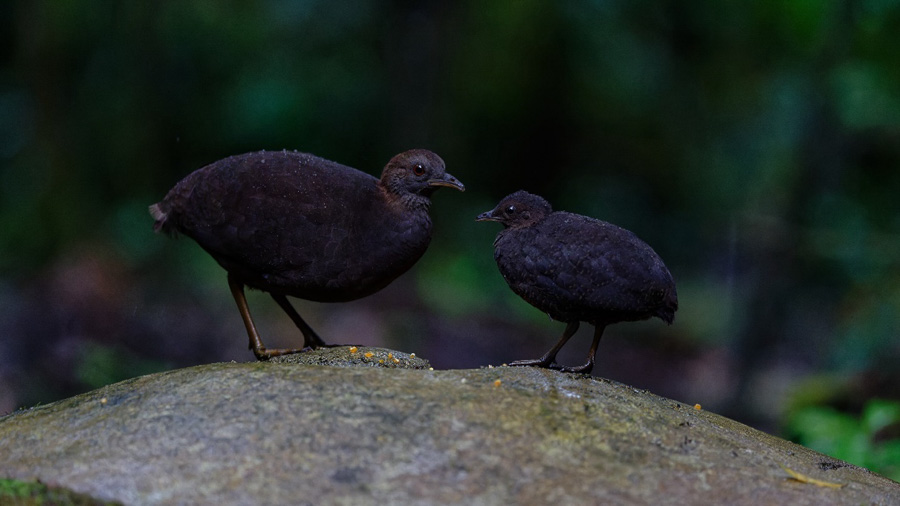
Cinereous Tinamous with a chick (photo Dr Uwe Speck).
Following breakfast, our first mission was to find the handsome Wire-crested Thorntail, a tropical foothill hummingbird found between 5,900 and 2,900 feet (1,800 and 900 meters). We enjoyed some already-seen hummingbirds, such as Black-breasted Mango. However, we also saw Green Hermit, Many-spotted Hummingbird, and Blue-fronted Lancebill before we spotted a stunning male Wire-crested Thorntail.
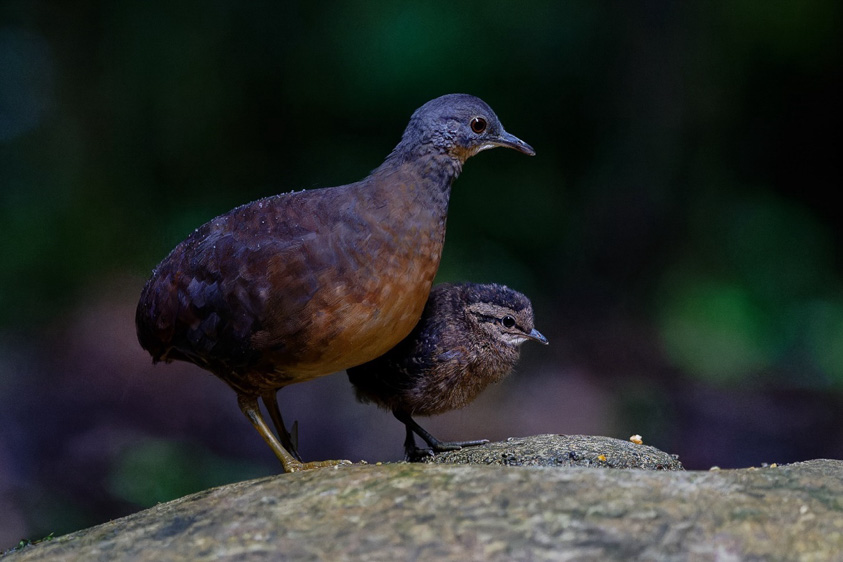
Little Tinamou also witha tiny chick, what a morning! (photo Dr Uwe Speck).
We saw some birds around the gardens, including Guira Tanager, Red-billed Tyrannulet, and Inambari Woodcreeper (named after the Inambari region in the Madre de Dios State in the southern Amazonia of Peru). We moved on and started to climb up the Abra Patricia Mountains again before driving through the rain to Huembo, where we spent the night.
Day 17, 26th May 2024. Utcubamba valley
We left Huembo and set off towards Pedro Ruiz. We arrived at the Chachapoyas Road following the mid and upper Utcubamba River, where we admired the scenic valley with its rocky formations. Our first stop produced Cliff Flycatcher, Black Phoebe, and Torrent Tyrannulet, but more importantly, the endemic Speckle-chested Piculet, which showed and behaved very well for us.
We continued along the road and entered the drier section at 5,900 feet (1,800 meters) elevation, where we had fantastic views of Golden-rumped Euphonia, Buff-bellied Tanager, Line-cheeked and Azara’s Spinetail, Barred Becard, a juvenile Black-capped Sparrow (nigriceips race), Streaked Xenops, Maranon Tyrannulet, Yellow-bellied Elaenia, Chivi Vireo, Inca Jay, White-lined Tanager, Silver-backed Tanager, and Slate-throated Whitestart.
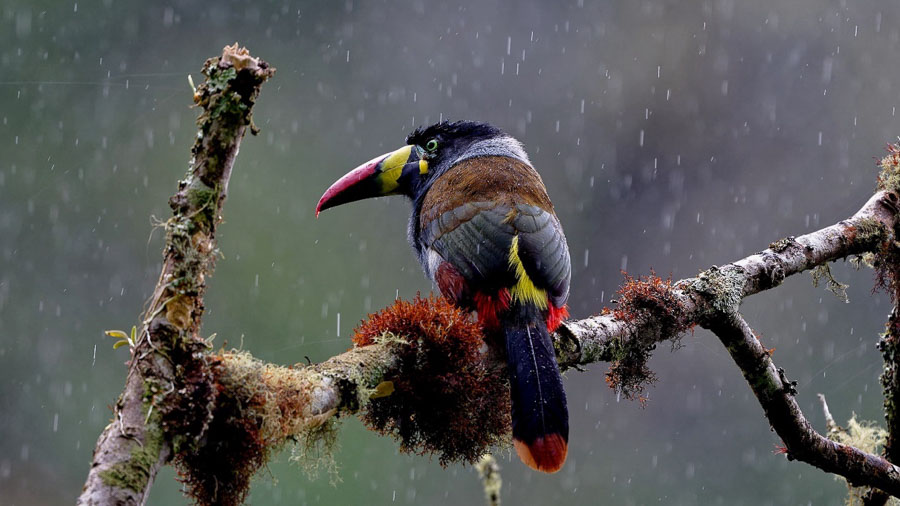
Grey-breasted Mountain Toucan in the never-ending drizzle (photo Dr Uwe Speck).
In the afternoon, we explored the Atuen Road above Leymebamba and got two targets: the exquisite, Grey-breasted Mountain Toucan and the majestic Andean Condor. We could not escape the drizzle; however, we got a mixed feeding flock with Pearled Treerunner, Streaked Tuftedcheek, Capped Conebill, Superciliaried Hemispingus, White-banded Tyrannulet, Russet-crowned Warbler, Beryl-spangled, Blue-and-black and Blue-capped Tanagers, and Brown-capped Vireo. We also found White-collared Jay, Smoke-colored Pewee, Golden-headed Quetzal (heard only), and had a fantastic view of Crimson-mantled Woodpecker.
Day 18, 27th May 2024. Abra Barro Negro and Leymebamba
We started the day with a lovely coffee and breakfast from our friend Azelita at Kentitambo Lodge, where we were based. We drove up to the Abra Barro Negro pass at 11,800 feet (3,600 meters) and explored the cloud forest on both slopes. Our main target was the endemic and secretive Russet-mantled Softtail. We did remarkably well with this localized species, which can still be seen in these mountains, despite rampant deforestation and human encroachment.
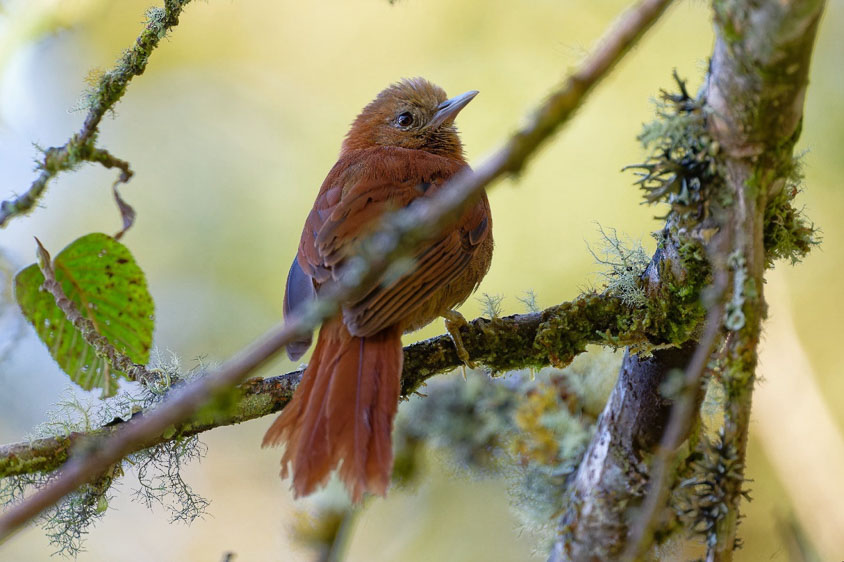
The endemic Russet-mantled Softtail at Abra Barro Negro (photo Dr Uwe Speck).
We had Mountain Caracara and Aplomado Falcon posing nicely for us, as well as Sapphire-spangled Emerald, Tyrian Metaltail, Amethyst-throated Sunangel, Red-crested Cotinga, White-collared Jay, Masked Flowerpiercer, White-banded Tyrannulet, Spectacled Whitestart, and Andean Guan.
At the highest point on the pass, we saw Brown-bellied Swallows, Grass Wren, Many-striped Canastero, Paramo Pipit, White-throated Hawk, Cream-winged Cinclodes, and White-chinned Thistletail. We worked hard for Neblina Tapaculo, but only a participant sitting next to me managed to get a glimpse of this “mouse in the grass”. We saw Brown-backed Chat-Tyrant, Tufted Tit-Tyrant, Crowned Chat-Tyrant, Scarlet-bellied Mountain Tanager, Moustached Flowerpiercer,and Coppery Metaltail – an endemic of the northern and central elfin forest in the Peruvian Andes.
We heard a Yungas Pygmy Owl, but could not locate it, which was a real disappointment for me. We returned to the lodge around midday and saw our only Rainbow Starfrontlet of the trip. In the afternoon, we returned to the western slope of the pass. After a lull in activity, we saw the Yungas Pygmy Owl,which, after our challenges earlier, felt good, and the participants were happy. Additionally, we saw Rufous-browed Peppershrike, Utcubamba Tapaculo (a recent split from Blackish Tapaculo), Blue-backed Conebill, Highland Elaenia, Shining Sunbeam, and we got a glimpse of a Sharp-shinned Hawk.
The plan was to stay out until dusk to try for a few species of owls, but the rain started again, and we retreated for dinner. Later on, with the constant drizzle continuing, we played for the endemic Koepcke’s Screech Owl, which at first responded distantly and then came to us. Many dogs were barking from houses in the area, making any further owling a nightmare.
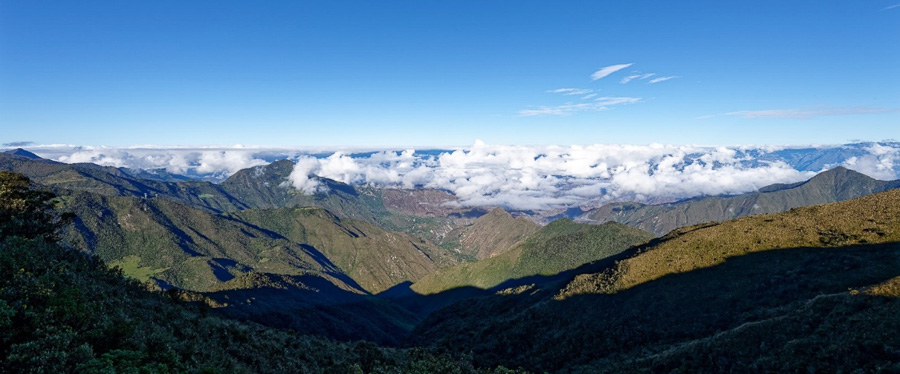
Views from Abra Barro Negro at 11,800 feet (3,600 meters) elevation (photo Dr Uwe Speck).
Day 19, 28th May 2024. Balsas and transfer to Cajamarca
We drove down to the Marañon Valley in Balsas at 04.30 am to be there around 07.00 am. This was a busy day as we aimed to get the big five species of the Marañon Valley, on the southern border of the Amazonas state and Cajamarca. We arrived at a good time, and we started to get species such as Croaking Ground Dove, Long-tailed Mockingbird, Hepatic Tanager, Andean Emerald, Spot-throated Hummingbird, and the first of the five endemics Buff-bridled Inca Finch.
Suddenly, I asked the driver to stop the vehicle when I noticed the call of the much-desired Yellow-faced Parrotlet. Shortly afterwards, we were enjoying great views of this Vulnerable species, which is vanishing from its tiny range due to habitat loss.
Then we tried for Maranon Pigeon, which we saw well but only in flight above the river. We heard the endemic Black-necked Woodpecker, which we missed along the Utcubamba River. However, it refused to show and remained a heard-only species.
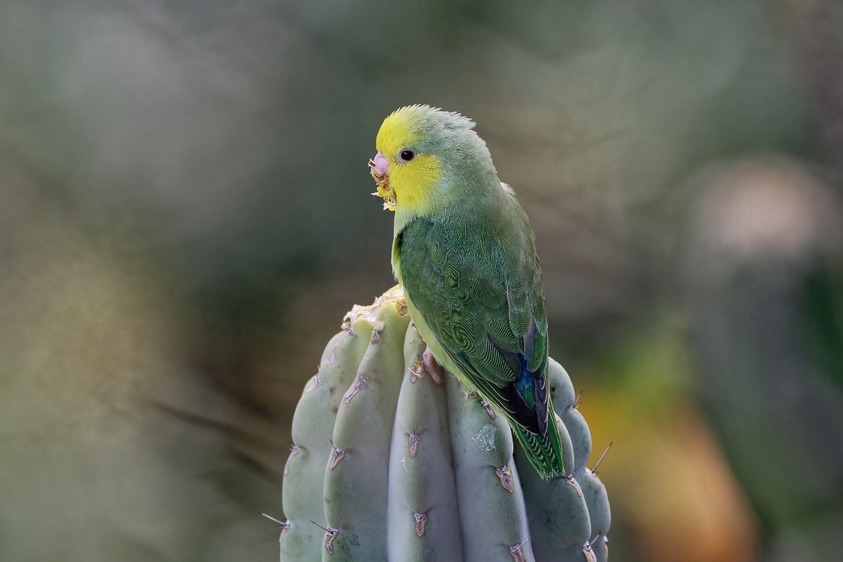
Yellow-faced Parrotlet – jewel of the Marañon (photo Dr Uwe Speck).
We rushed to continue driving up to Hacienda El Limon, where we had great views of the endemic Grey-winged Inca Finch and fly-by views of the secretive and endemic Chestnut-backed Thornbird near its nest.With thebig five of the Marañon in the bag, we continued our journey towards Cajamarca. It is possible to break the long journey by staying in the town of Celendin. However, there were several complications, including road construction projects and community tension regarding mining in the area, so we decided to push through to Cajamarca. On the way, we manage to see Black-billed Shrike-Tyrant, Andean Flicker, Puna Ibis, Andean Lapwing, and American Kestrel.
Day 20, 29th May 2024. Chonta Canyon
Our last birding morning took us to the Chonta Canyon near the pre-Hispanic site of Otuzco, outside Cajamarca. The weather was a bit chilly, but we had a memorable final morning finding the endemic, localized and Endangered Grey-bellied Comet, which showed exceptionally well for us, allowing us to get three different males and a single female.
In addition to the comet, we saw Black-crested Warbler, Black-crested Tit-Tyrant, Rufous-naped Ground Tyrant, Blue-and-yellow Tanager, Peruvian Sierra Finch, White-browed Chat-Tyrant, Band-tailed Seedeater, Smoky-brown Woodpecker, Andean Swift, Black-chested Buzzard-Eagle, Giant Hummingbird, White-winged Cinclodes, Yellow-billed Tit-Tyrant, and the endemic Black Metaltail.
For the grand finale, we witnessed an Andean Fox (also known as Andean Culpeo), the largest canid in the Andes, hunting a chicken.
We returned to Cajamarca, where we had a nice lunch before walking around the colonial town, whose buildings date back to the 16th and 17th centuries. This is the city where the Spaniards met the Inca empire and finished with the last Inca ruler, Atahualpa.
This was a great trip with a lovely group of enthusiastic birders, fantastic spotters and good travelers who quickly adapted to the circumstances of the trip. We had long drives, daily early starts, occasional picnic lunches, and a few basic accommodations, however, these events were balanced by comfortable lodges, excellent restaurants, enjoyable drinks, and an outstanding selection of Peruvian birds!
Thanks to all of you, and I hope to see you again on another Birding Ecotours trip!
Bird List – Following IOC 14.1
Birds ‘heard only’ are marked with (H) after the common name, all other species were seen.
| Common name | Scientific name |
| Tinamidae | |
| Hooded Tinamou | Nothocercus nigrocapillus |
| Cinereous Tinamou | Crypturellus cinereus |
| Little Tinamou | Crypturellus soui |
| Brown Tinamou | Crypturellus obsoletus |
| Pale-browed Tinamou (H) | Crypturellus transfasciatus |
| Tataupa Tinamou (H) | Crypturellus tataupa |
| Anatidae | |
| Black-bellied Whistling Duck | Dendrocygna autumnalis |
| Torrent Duck | Merganetta armata |
| Comb Duck | Sarkidiornis sylvicola |
| Cinnamon Teal | Spatula cyanoptera |
| Yellow-billed Teal | Anas flavirostris |
| White-cheeked Pintail | Anas bahamensis |
| Cracidae | |
| Speckled Chachalaca (H) | Ortalis guttata |
| Andean Guan | Penelope montagnii |
| White-winged Guan | Penelope albipennis |
| Odontophoridae | |
| Rufous-breasted Wood Quail | Odontophorus speciosus |
| Caprumulgidae | |
| Parauque (H) | Nyctidromus albicollis |
| Band-winged Nightjar | Systellura longirostris |
| Steatornithidae | |
| Oilbird | Steatornis caripensis |
| Nyctibiidae | |
| Common Potoo (H) | Nyctibius griseus |
| Apodidae | |
| Chestnut-collared Swift | Streptoprocne rutila |
| White-collared Swift | Streptoprocne zonaris |
| Short-tailed Swift | Chaetura brachyura |
| Andean Swift | Aeronautes andecolus |
| White-tipped Swift | Aeronautes montivagus |
| Fork-tailed Palm Swift | Tachornis squamata |
| Trochilidae | |
| White-necked Jacobin | Florisuga mellivora |
| Pale-tailed Barbthroat | Threnetes leucurus |
| Black-throated Hermit | Phaethornis atrimentalis |
| Green Hermit | Phaethornis guy |
| Tawny-bellied Hermit | Phaethornis syrmatophorus |
| Great-billed Hermit | Phaethornis malaris |
| Koepcke’s Hermit | Phaethornis koepckeae |
| Blue-fronted Lancebill | Doryfera johannae |
| Green-fronted Lancebill | Doryfera ludovicae |
| Brown Violetear | Colibri delphinae |
| Sparkling Violetear | Colibri coruscans |
| Lesser Violetear | Colibri cyanotus |
| Black-throated Mango | Anthracothorax nigricollis |
| Purple-throated Sunangel | Heliangelus viola |
| Royal Sunangel | Heliangelus regalis |
| Wire-crested Thorntail | Discosura popelairii |
| Rufous-crested Coquette | Lophornis delattrei |
| Speckled Hummingbird | Adelomyia melanogenys |
| Long-tailed Sylph | Aglaiocercus kingii |
| Grey-bellied Comet | Taphrolesbia griseiventris |
| Green-tailed Trainbearer | Lesbia nuna |
| Tyrian Metaltail | Metallura tyrianthina |
| Coppery Metaltail | Metallura theresiae |
| Black Metaltail | Metallura phoebe |
| Greenish Puffleg | Haplophaedia aureliae |
| Emerald-bellied Puffleg | Eriocnemis aline |
| Sapphire-vented Puffleg | Eriocnemis luciani |
| Marvelous Spatuletail | Loddigesia mirabilis |
| Shining Sunbeam | Aglaeactis cupripennis |
| Bronzy Inca | Coeligena coeligena |
| Collared Inca | Coeligena torquata |
| Rainbow Starfrontlet | Coeligena iris |
| Sword-billed Hummingbird | Ensifera ensifera |
| Chestnut-breasted Coronet | Boissonneaua matthewsii |
| Peruvian Racket-tail | Ocreatus peruanus |
| Gould’s Jewelfront | Heliodoxa aurescens |
| Fawn-breasted Brilliant | Heliodoxa rubinoides |
| Violet-fronted Brilliant | Heliodoxa leadbeateri |
| Giant Hummingbird | Patagona gigas |
| Long-billed Starthroat | Heliomaster longirostris |
| Purple-collared Woodstar | Myrtis fanny |
| White-bellied Woodstar | Chaetocercus mulsant |
| Little Woodstar | Chaetocercus bombus |
| Short-tailed Woodstar | Myrmia micrura |
| Blue-tailed Emerald | Chlorostilbon mellisugus |
| Violet-headed Hummingbird | Klais guimeti |
| Grey-breasted Sabrewing | Campylopterus largipennis |
| Fork-tailed Woodnymph | Thalurania furcata |
| Tumbes Hummingbird | Thaumasius baeri |
| Spot-throated Hummingbird | Thaumasius taczanowskii |
| Many-spotted Hummingbird | Taphrospilus hypostictus |
| Amazilia Hummingbird | Amazilis amazilia |
| Andean Emerald | Uranomitra franciae |
| Golden-tailed Sapphire | Chrysuronia oenone |
| Sapphire-spangled Emerald | Chionomesa lactea |
| White-bellied Hummingbird | Elliotomyia chionogaster |
| Cuculidae | |
| Smooth-billed Ani | Crotophaga ani |
| Groove-billed Ani | Crotophaga sulcirostris |
| Striped Cuckoo | Tapera naevia |
| Little Cuckoo | Coccycua minuta |
| Squirrel Cuckoo | Piaya cayana |
| Columbidae | |
| Rock Dove | Columba livia |
| Ruddy Pigeon | Patagioenas subvinacea |
| Maranon Pigeon | Patagioenas oenops |
| Croaking Ground Dove | Columbina cruziana |
| Ruddy Ground Dove | Columbina talpacoti |
| Blue Ground Dove | Claravis pretiosa |
| Bare-faced Ground Dove | Metriopelia ceciliae |
| White-throated Quail-Dove | Zentrygon frenata |
| White-tipped Dove | Leptotila verreauxi |
| Eared Dove | Zenaida auriculata |
| West Peruvian Dove | Zenaida meloda |
| Rallidae | |
| Spotted Rail | Pardirallus maculatus |
| Plumbeous Rail | Pardirallus sanguinolentus |
| Common Gallinule | Gallinula galeata |
| Purple Gallinule | Porphyrio martinica |
| Andean Coot | Fulica ardesiaca |
| Russet-crowned Crake (H) | Rufirallus viridis |
| Rufous-sided Crake | Laterallus melanophaius |
| Aramidae | |
| Limpkin | Aramus guarauna |
| Podicipedidae | |
| Least Grebe | Tachybaptus dominicus |
| Pied-billed Grebe | Podilymbus podiceps |
| Great Grebe | Podiceps major |
| Burhinidae | |
| Peruvian Thick-Knee | Hesperoburhinus superciliaris |
| Haematopodidae | |
| American Oystercatcher | Haematopus palliatus |
| Blackish Oystercatcher | Haematopus ater |
| Recurvirostridae | |
| Black-necked Stilt | Himantopus mexicanus |
| Charadriidae | |
| Andean Lapwing | Vanellus resplendens |
| Kildeer | Charadrius vociferus |
| Snowy Plover | Anarhynchus nivosus |
| Pied Plover | Hoploxypterus cayanus |
| Jacanidae | |
| Wattled Jacana | Jacana jacana |
| Thinocoridae | |
| Least Seedsnipe | Thinocorus rumicivorus |
| Scolopacidae | |
| Hudsonian Whimbrel | Numenius hudsonicus |
| Hudsonian Godwit | Limosa haemastica |
| Wilson’s Phalarope | Phalaropus tricolor |
| Spotted Sandpiper | Actitis macularius |
| Willet | Tringa semipalmata |
| Lesser Yellowlegs | Tringa flavipes |
| Greater Yellowlegs | Tringa melanoleuca |
| Ruddy Turnstone | Arenaria interpres |
| Stilt Sandpiper | Calidris himantopus |
| Pectoral Sandpiper | Calidris melanotos |
| Laridae | |
| Black Skimmer | Rynchops niger |
| Inca Tern | Larosterna inca |
| Belcher’s Gull | Larus belcheri |
| Kelp Gull | Larus dominicanus |
| Grey Gull | Leucophaeus modestus |
| Grey-headed Gull | Chroicocephalus cirrocephalus |
| Franklin’s Gull | Leucophaeus pipixcan |
| Spheniscidae | |
| Humboldt Penguin | Spheniscus humboldti |
| Phalacrocoridae | |
| Red-legged Cormorant | Poikilocarbo gaimardi |
| Guanay Cormorant | Leucocarbo bougainvillii |
| Neotropic Cormorant | Nannopterum brasilianum |
| Pelecanidae | |
| Peruvian Pelican | Pelecanus thagus |
| Sulidae | |
| Peruvian Booby | Sula variegata |
| Threskiornithidae | |
| Puna Ibis | Plegadis ridgwayi |
| Ardeidae | |
| Fasciated Tiger Heron | Tigrisoma fasciatum |
| Black-crowned Night Heron | |
| Striated Heron | Butorides striata |
| Western Cattle Egret | Bubulcus ibis |
| Great Egret | Ardea alba |
| Little Blue Heron | Egretta caerulea |
| Snowy Egret | Egretta thula |
| Opisthocomidae | |
| Hoatzin | Opisthocomus hoazin |
| Cathartidae | |
| Andean Condor | Vultur gryphus |
| King Vulture | Sarcoramphus papa |
| Black Vulture | Coragyps atratus |
| Turkey Vulture | Cathartes aura |
| Accipitridae | |
| Swallow-tailed Kite | Elanoides forficatus |
| Pearl Kite | Gampsonyx swainsonii |
| Double-toothed Kite | Harpagus bidentatus |
| Plain-breasted Hawk | Accipiter ventralis |
| Plumbeous Kite | Ictinia plumbea |
| Roadside Hawk | Rupornis magnirostris |
| Harris’s Hawk | Parabuteo unicinctus |
| Variable Hawk | Geranoaetus polyosoma |
| Black-chested Buzzard-Eagle | Geranoaetus melanoleucus |
| White-throated Hawk | Buteo albigula |
| Short-tailed Hawk | Buteo brachyurus |
| Zone-tailed Hawk | Buteo albonotatus |
| Tytonidae | |
| American Barn Owl | Tyto furcata |
| Strigidae | |
| Long-whiskered Owlet | Xenoglaux loweryi |
| Burrowing Owl | Athene cunicularia |
| Yungas Pygmy Owl | Glaucidium bolivianum |
| Ferruginous Pygmy Owl | Glaucidium brasilianum |
| Pacific Pygmy Owl | Glaucidium peruanum |
| Koepcke’s Screech Owl (H) | Megascops koepckeae |
| West Peruvian Screech Owl | Megascops roboratus |
| Rufous-banded Owl (H) | Strix albitarsis |
| Trogonidae | |
| Golden-headed Quetzal (H) | Pharomachrus auriceps |
| Crested Quetzal | Pharomachrus antisianus |
| Masked Trogon | Trogon personatus |
| Ecuadorian Trogon | Trogon mesurus |
| Green-backed Trogon | Trogon viridis |
| Alcedinidae | |
| Amazon Kingfisher | Chloroceryle amazona |
| Green Kingfisher | Chloroceryle americana |
| Ringed Kingfisher | Megaceryle torquata |
| Momotidae | |
| Amazonian Motmot (H) | Momotus momota |
| Whooping Motmot | Momotus subrufescens |
| Capitonidae | |
| Gilded Barbet | Capito auratus |
| Galbulidae | |
| Bluish-fronted Jacamar | Galbula cyanescens |
| Bucconidae | |
| White-faced Nunbird (H) | Hapaloptila castanea |
| Black-fronted Nunbird | Monasa nigrifrons |
| Swallow-winged Puffbird | Chelidoptera tenebrosa |
| Ramphastidae | |
| Black-throated Toucanet | Aulacorhynchus atrogularis |
| Chestnut-eared Aracari | Pteroglossus castanotis |
| Golden-collared Toucanet | Selenidera reinwardtii |
| Grey-breasted Mountain Toucan | Andigena hypoglauca |
| Picidae | |
| Speckle-chested Piculet | Picumnus steindachneri |
| Lafresnaye’s Piculet | Picumnus lafresnayi |
| Yellow-tufted Woodpecker | Melanerpes cruentatus |
| Little Woodpecker | Veniliornis passerinus |
| Scarlet-backed Woodpecker | Veniliornis callonotus |
| Red-stained Woodpecker | Veniliornis affinis |
| Smoky-brown Woodpecker | Leuconotopicus fumigatus |
| Golden-olive Woodpecker | Colaptes rubiginosus |
| Crimson-mantled Woodpecker | Colaptes rivolii |
| Black-necked Woodpecker (H) | Colaptes atricollis |
| Spot-breasted Woodpecker | Colaptes punctigula |
| Andean Flicker | Colaptes rupicola |
| Cream-colored Woodpecker | Celeus flavus |
| Lineated Woodpecker | Dryocopus lineatus |
| Crimson-bellied Woodpecker | Campephilus haematogaster |
| Falconidae | |
| Black Caracara | Daptrius ater |
| Mountain Caracara | Phalcoboenus megalopterus |
| Crested Caracara | Caracara plancus |
| Yellow-headed Caracara | Milvago chimachima |
| Laughing Falcon | Herpetotheres cachinnans |
| Collared Forest Falcon (H) | Micrastur semitorquatus |
| American Kestrel | Falco sparverius |
| Aplomado Falcon | Falco femoralis |
| Bat Falcon | Falco rufigularis |
| Psittacidae | |
| Andean Parakeet (H) | Bolborhynchus orbygnesius |
| Cobalt-winged Parakeet | Brotogeris cyanoptera |
| White-capped Parrot | Pionus seniloides |
| Blue-headed Parrot | Pionus menstruus |
| Scaly-naped Amazon | Amazona mercenarius |
| Pacific Parrotlet | Forpus coelestis |
| Yellow-faced Parrotlet | Forpus xanthops |
| Dusky-headed Parakeet | Aratinga weddellii |
| Cordilleran Parakeet | Psittacara frontatus |
| Mitred Parakeet | Psittacara mitratus |
| Red-masked Parakeet | Psittacara erythrogenys |
| White-eyed Parakeet | Psittacara leucophthalmus |
| Furnariidae | |
| Coastal Miner | Geositta peruviana |
| Thick-billed Miner | Geositta crassirostris |
| Greyish Miner | Geositta marítima |
| Olivaceous Woodcreeper | Sittasomus griseicapillus |
| Tyrannine Woodcreeper | Dendrocincla tyrannina |
| Amazonian Barred Woodcreeper | Dendrocolaptes certhia |
| Olive-backed Woodcreeper | Xiphorhynchus triangularis |
| Streak-headed Woodcreeper | Lepidocolaptes souleyetii |
| Montane Woodcreeper | Lepidocolaptes lacrymiger |
| Inambari Woodcreeper | Lepidocolaptes fatimalimae |
| Streaked Xenops | Xenops rutilans |
| Pale-legged Hornero | Furnarius leucopus |
| Pacific Hornero | Furnarius cinnamomeus |
| Cream-winged Cinclodes | Cinclodes albiventris |
| White-winged Cinclodes | Cinclodes atacamensis |
| Buff-browed Foliage-gleaner | Syndactyla rufosuperciliata |
| Rufous-necked Foliage-gleaner | Syndactyla ruficollis |
| Henna-hooded Foliage-gleaner | Clibanornis erythrocephalus |
| Ochre-throated Foliage-gleaner (H) | Automolus ochrolaemus |
| Striped Treehunter | Thripadectes holostictus |
| Black-billed Treehunter (H) | Thripadectes melanorhynchus |
| Pearled Treerunner | Margarornis squamiger |
| Streaked Tuftedcheek | Pseudocolaptes boissonneautii |
| Point-tailed Palmcreeper | Berlepschia rikeri |
| Rufous-fronted Thornbird | Phacellodomus rufifrons |
| Chestnut-backed Thornbird | Phacellodomus dorsalis |
| Cactus Canastero | Pseudasthenes cactorum |
| Many-striped Canastero | Asthenes flammulata |
| White-chinned Thistletail | Asthenes fuliginosa |
| Russet-mantled Softtail | Cranioleuca berlepschi |
| Line-cheeked Spinetail | Cranioleuca antisiensis |
| Maranon Spinetail | Synallaxis maranonica |
| Chinchipe Spinetail | Synallaxis chinchipensis |
| Necklaced Spinetail | Synallaxis stictothorax |
| Dark-breasted Spinetail | Synallaxis albigularis |
| Azara’s Spinetail | Synallaxis azarae |
| Rufous Spinetail | Synallaxis unirufa |
| Thamnophilidae | |
| Stripe-chested Antwren (H) | Myrmotherula longicauda |
| White-flanked Antwren (H) | Myrmotherula axillaris |
| Ash-throated Antwren | Herpsilochmus parkeri |
| Collared Antshrike | Thamnophilus bernardi |
| Lined Antshrike (H) | Thamnophilus tenuepunctatus |
| Chapman’s Antshrike | Thamnophilus zarumae |
| Plain-winged Antshrike (H) | Thamnophilus schistaceus |
| Mouse-colored Antshrike (H) | Thamnophilus murinus |
| Uniform Antshrike | Thamnophilus unicolor |
| Northern Slaty Antshrike | Thamnophilus punctatus |
| Variable Antshrike | Thamnophilus caerulescens |
| Rufous-capped Antshrike (H) | Thamnophilus ruficapillus |
| Streak-headed Antbird | Drymophila striaticeps |
| Peruvian Warbling Antbird | Hypocnemis peruviana |
| Northern Chestnut-tailed Antbird | Sciaphylax castanea |
| Blackish Antbird | Cercomacroides nigrescens |
| Western Fire-eye (H) | Pyriglena maura |
| Formicariidae | |
| Black-faced Antthrush (H) | Formicarius analis |
| Grallaridae | |
| Chestnut-crowned Antpitta | Grallaria ruficapilla |
| Rusty-tinged Antpitta | Grallaria przewalskii |
| Chestnut Antpitta | Grallaria blakei |
| Ochre-fronted Antpitta | Grallaricula ochraceifrons |
| Conopophagidae | |
| Chestnut-crowned Gnateater (H) | Conopophaga castaneiceps |
| Rhinocryptidae | |
| Neblina Tapaculo | Scytalopus altirostris |
| Rufous-vented Tapaculo (H) | Scytalopus femoralis |
| Utcubamba Tapaculo | Scytalopus intermedius |
| White-crowned Tapaculo | Scytalopus atratus |
| Melanopareia | |
| Elegant Crescentchest | Melanopareia elegans |
| Maranon Crescentchest | Melanopareia maranonica |
| Tyrannidae | |
| Wing-barred Piprites | Piprites chloris |
| Yellow-crowned Tyrannulet | Tyrannulus elatus |
| Forest Elaenia | Myiopagis gaimardii |
| Yellow-bellied Elaenia | Elaenia flavogaster |
| Pacific Elaenia | Myiopagis subplacens |
| Sierran Elaenia | Elaenia pallatangae |
| Highland Elaenia | Elaenia obscura |
| Southern Beardless Tyrannulet | Camptostoma obsoletum |
| White-banded Tyrannulet | Mecocerculus stictopterus |
| Rufous-winged Tyrannulet | Mecocerculus calopterus |
| Sulphur-bellied Tyrannulet | Mecocerculus minor |
| Black-crested Tit-Tyrant | Anairetes nigrocristatus |
| Pied-crested Tit-Tyrant | Anairetes reguloides |
| Yellow-billed Tit-Tyrant | Anairetes flavirostris |
| Tufted Tit-Tyrant | Anairetes parulus |
| Torrent Tyrannulet | Serpophaga cinérea |
| Southern Mouse-colored Tyrannulet | Nesotriccus murinus |
| Tumbesian Tyrannulet | Nesotriccus tumbezanus |
| Maranon Tyrannulet | Nesotriccus maranonicus |
| Rufous-headed Pygmy Tyrant | Pseudotriccus ruficeps |
| Fulvous-crowned Scrub Tyrant | Euscarthmus fulviceps |
| Grey-and-white Tyrannulet | Pseudelaenia leucospodia |
| Red-billed Tyrannulet | Zimmerius cinereicapilla |
| Peruvian Tyrannulet | Zimmerius viridiflavus |
| Mottle-cheeked Tyrannulet | Phylloscartes ventralis |
| Streak-necked Flycatcher | Mionectes striaticollis |
| Slaty-capped Flycatcher | Leptopogon superciliaris |
| Inca Flycatcher | Leptopogon taczanowskii |
| Mouse-grey Flycatcher | Myiophobus crypterythrus |
| Rufescent Flycatcher | Myiophobus rufescens |
| Many-colored Rush Tyrant | Tachuris rubrigastra |
| Black-throated Tody-Tyrant (H) | Hemitriccus granadensis |
| Short-tailed Pygmy Tyrant | Myiornis ecaudatus |
| Scale-crested Pygmy Tyrant (H) | Lophotriccus pileatus |
| Lulu’s Tody-Flycatcher | Poecilotriccus luluae |
| Common Tody-Flycatcher | Todirostrum cinereum |
| Yellow-olive Flatbill | Tolmomyias sulphurescens |
| Grey-crowned Flatbill (H) | Tolmomyias poliocephalus |
| Cinnamon Flycatcher | Pyrrhomyias cinnamomeus |
| Cliff Flycatcher | Hirundinea ferruginea |
| Black Phoebe | Sayornis nigricans |
| Olive Tufted Flycatcher | Mitrephanes olivaceus |
| Smoke-colored Pewee | Contopus fumigatus |
| Tumbes Pewee | Contopus punensis |
| Vermilion Flycatcher | Pyrocephalus obscurus |
| Rufous-naped Ground Tyrant | Muscisaxicola rufivertex |
| Dark-faced Ground Tyrant | Muscisaxicola maclovianus |
| Rufous-tailed Tyrant | Knipolegus poecilurus |
| Black-billed Shrike-Tyrant | Agriornis montanus |
| Tumbes Tyrant | Tumbezia salvini |
| White-browed Chat-Tyrant | Ochthoeca leucophrys |
| Maroon-belted Chat-Tyrant (H) | Ochthoeca thoracica |
| Rufous-breasted Chat-Tyrant | Ochthoeca leucophrys |
| Piura Chat-Tyrant | Ochthoeca piurae |
| Brown-backed Chat-Tyrant | Ochthoeca fumicolor |
| Crowned Chat-Tyrant | Silvicultrix frontalis |
| Short-tailed Field Tyrant | Muscigralla brevicauda |
| Long-tailed Tyrant | Colonia colonus |
| Social Flycatcher | Myiozetetes similis |
| Grey-capped Flycatcher | Myiozetetes granadensis |
| Great Kiskadee | Pitangus sulphuratus |
| Baird’s Flycatcher | Myiodynastes bairdii |
| Streaked Flycatcher | Myiodynastes maculatus |
| Boat-billed Flycatcher | Megarynchus pitangua |
| Tropical Kingbird | Tyrannus melancholicus |
| Rufous Flycatcher | Myiarchus semirufus |
| Pale-edged Flycatcher | Myiarchus cephalotes |
| Sooty-crowned Flycatcher | Myiarchus phaeocephalus |
| Brown-crested Flycatcher | Myiarchus tyrannulus |
| Short-crested Flycatcher | Myiarchus ferox |
| Cotingidae | |
| Green-and-black Fruiteater | Pipreola riefferii |
| Peruvian Plantcutter | Phytotoma raimondii |
| Red-crested Cotinga | Ampelion rubrocristatus |
| Chestnut-crested Cotinga | Ampelion rufaxilla |
| Red-ruffed Fruitcrow | Pyroderus scutatus |
| Pipridae | |
| Painted Manakin (H) | Machaeropterus eckelberryi |
| Fiery-capped Manakin (H) | Machaeropterus pyrocephalus |
| White-crowned Manakin | Pseudopipra pipra |
| Golden-headed Manakin | Ceratopipra erythrocephala |
| Tityridae | |
| Masked Tityra | Tityra semifasciata |
| Black-and-white Becard | Pachyramphus albogriseus |
| Barred Becard | Pachyramphus versicolor |
| White-winged Becard | Pachyramphus polychopterus |
| Slaty Becard | Pachyramphus spodiurus |
| Vireonidae | |
| Rufous-browed Peppershrike | Cyclarhis gujanensis |
| Chivi Vireo | Vireo chivi |
| Brown-capped Vireo | Vireo leucophrys |
| Corvidae | |
| White-collared Jay | Cyanolyca viridicyanus |
| White-tailed Jay | Cyanocorax mystacalis |
| Inca Jay | Cyanocorax yncas |
| Violaceous Jay (H) | Cyanocorax violaceus |
| Hirundinidae | |
| Tumbes Swallow | Tachycineta stolzmanni |
| White-winged Swallow | Tachycineta albiventer |
| White-banded Swallow | Atticora fasciata |
| Blue-and-white Swallow | Pygochelidon cyanoleuca |
| Brown-bellied Swallow | Orochelidon murina |
| Grey-breasted Martin | Progne chalybea |
| Southern Rough-winged Swallow | Stelgidopteryx ruficollis |
| Donacobiidae | |
| Black-capped Donacobius | Donacobius atricapilla |
| Troglodytidae | |
| Fasciasted Wren | Campylorhynchus fasciatus |
| Thrush-like Wren | Campylorhynchus turdinus |
| Grass Wren | Cistothorus platensis |
| Coraya Wren (H) | Pheugopedius coraya |
| Speckle-breasted Wren | Pheugopedius sclateri |
| Superciliated Wren | Cantorchilus superciliaris |
| House Wren | Troglodytes aedon |
| Grey-breasted Wood Wren (H) | Henicorhina leucophrys |
| Bar-winged Wood Wren | Henicorhina leucoptera |
| Southern Nightingale Wren (H) | Microcerculus marginatus |
| Chestnut-breasted Wren (H) | Cyphorhinus thoracicus |
| Polioptilidae | |
| Tropical Gnatcatcher | Polioptila plumbea |
| White-browed Gnatcatcher | Polioptila bilineata |
| Mimidae | |
| Long-tailed Mockingbird | Mimus longicaudatus |
| Turdidae | |
| Andean Solitaire | Myadestes ralloides |
| Andean Slaty Thrush | Turdus nigriceps |
| Plumbeous-backed Thrush | Turdus reevei |
| Great Thrush | Turdus fuscater |
| Maranon Thrush | Turdus maranonicus |
| Black-billed Thrush | Turdus ignobilis |
| Cinclidae | |
| White-capped Dipper | Cinclus leucocephalus |
| Passeridae | |
| House Sparrow | Passer domesticus |
| Motacillidae | |
| Peruvian Pipit | Anthus peruvianus |
| Paramo Pipit | Anthus bogotensis |
| Fringillidae | |
| Lesser Goldfinch | Spinus psaltria |
| Hooded Siskin | Spinus magellanicus |
| Olivaceous Siskin | Spinus olivaceus |
| Purple-throated Euphonia | Euphonia chlorotica |
| Thick-billed Euphonia | Euphonia laniirostris |
| Orange-bellied Euphonia | Euphonia xanthogaster |
| White-vented Euphonia | Euphonia minuta |
| White-lored Euphonia | Euphonia chrysopasta |
| Golden-rumped Euphonia | Chlorophonia cyanocephala |
| Passerellidae | |
| Common Chlorospingus | Chlorospingus flavopectus |
| Tumbes Sparrow | Rhynchospiza stolzmanni |
| Yellow-browed Sparrow | Ammodramus aurifrons |
| Orange-billed Sparrow (H) | Arremon aurantiirostris |
| Black-capped Sparrow | Arremon abeillei |
| Chestnut-capped Brushfinch | Arremon brunneinucha |
| Rufous-collared Sparrow | Zonotrichia capensis |
| White-headed Brushfinch | Atlapetes albiceps |
| White-winged Brushfinch | Atlapetes leucopterus |
| Bay-crowned Brushfinch | Atlapetes seebohmi |
| Yellow-breasted Brushfinch | Atlapetes latinuchus |
| Icteridae | |
| Peruvian Meadowlark | Leistes bellicosus |
| Yellow-billed Cacique (H) | Amblycercus holosericeus |
| Crested Oropendola | Psarocolius decumanus |
| Russet-backed Oropendola | Psarocolius angustifrons |
| Yellow-rumped Cacique | Cacicus cela |
| Yellow-tailed Oriole | Icterus mesomelas |
| White-edged Oriole | Icterus graceannae |
| Orange-backed Troupial | Icterus croconotus |
| Shiny Cowbird | Molothrus bonariensis |
| Giant Cowbird | Molothrus oryzivorus |
| Scrub Blackbird | Dives warczewiczi |
| Oriole Blackbird | Gymnomystax mexicanus |
| Pale-eyed Blackbird | Agelasticus xanthophthalmus |
| Parulidae | |
| Tropical Parula | Setophaga pitiayumi |
| Black-crested Warbler | Myiothlypis nigrocristata |
| Russet-crowned Warbler | Myiothlypis coronata |
| Three-banded Warbler | Basileuterus trifasciatus |
| Three-striped Warbler | Basileuterus tristriatus |
| Slate-throated Whitestart | Myioborus miniatus |
| Spectacled Whitestart | Myioborus melanocephalus |
| Cardinalidae | |
| Tooth-billed Tanager | Piranga lutea |
| Golden Grosbeak | Pheucticus chrysogaster |
| Thraupidae | |
| White-capped Tanager | Sericossypha albocristata |
| Little Inca Finch | Incaspiza watkinsi |
| Buff-bridled Inca Finch | Incaspiza laeta |
| Grey-winged Inca Finch | Incaspiza ortizi |
| Band-tailed Sierra Finch | Rhopospina alaudina |
| Green Honeycreeper | Chlorophanes spiza |
| Guira Tanager | Hemithraupis guira |
| Swallow Tanager | Tersina viridis |
| Purple Honeycreeper | Cyanerpes caeruleus |
| Blue Dacnis | Dacnis cayana |
| Black-faced Dacnis | Dacnis lineata |
| Bluish-grey Saltator | Saltator coerulescens |
| Streaked Saltator | Saltator striatipectus |
| Buff-throated Saltator | Saltator maximus |
| Golden-billed Saltator | Saltator aurantiirostris |
| Black-cowled Saltator | Saltator nigriceps |
| Bananaquit | Coereba flaveola |
| Dull-colored Grassquit | Asemospiza obscura |
| Red Pileated Finch | Coryphospingus cucullatus |
| White-lined Tanager | Tachyphonus Rufus |
| Yellow-backed Tanager | Hemithraupis flavicollis |
| Huallaga Tanager | Ramphocelus melanogaster |
| Silver-beaked Tanager | Ramphocelus carbo |
| Black-and-white Seedeater | Sporophila luctuosa |
| Chestnut-bellied Seed Finch | Sporophila angolensis |
| Black-billed Seed Finch | Sporophila atrirostris |
| Parrot-billed Seedeater | Sporophila peruviana |
| Drab Seedeater | Sporophila simplex |
| Chestnut-throated Seedeater | Sporophila telasco |
| Chestnut-bellied Seedeater | Sporophila castaneiventris |
| Cinereous Finch | Piezorina cinérea |
| Drab Hemispingus | Pseudospingus xanthophthalmus |
| Collared Warbling Finch | Poospiza hispaniolensis |
| Oleaginous Hemispingus | Sphenopsis frontalis |
| Buff-bellied Tanager | Thlypopsis inornata |
| Rufous-chested Tanager | Thlypopsis ornata |
| Superciliaried Hemispingus | Thlypopsis superciliaris |
| Capped Conebill | Conirostrum albifrons |
| Blue-backed Conebill | Blue-backed Conebill |
| Saffron Finch | Sicalis flaveola |
| Grassland Yellow Finch | Sicalis luteola |
| Raimondi’s Yellow Finch | Sicalis raimondii |
| Peruvian Sierra Finch | Phrygilus punensis |
| Ash-breasted Sierra Finch | Geospizopsis plebejus |
| Band-tailed Seedeater | Catamenia analis |
| Golden-eyed Flowerpiercer | Diglossa glauca |
| Bluish Flowerpiercer | Diglossa caerulescens |
| Moustached Flowerpiercer | Diglossa mystacalis |
| Masked Flowerpiercer | Diglossa cyanea |
| White-sided Flowerpiercer | Diglossa albilatera |
| Black-throated Flowerpiercer | Diglossa brunneiventris |
| Rusty Flowerpiercer | Diglossa sittoides |
| Yellow-throated Tanager | Iridosornis analis |
| Yellow-scarfed Tanager | Iridosornis reinhardti |
| Fawn-breasted Tanager | Pipraeidea melanonota |
| Blue-and-yellow Tanager | Rauenia bonariensis |
| Hooded Mountain Tanager | Buthraupis montana |
| Blue-capped Tanager | Sporathraupis cyanocephala |
| Grass-green Tanager | Chlorornis riefferii |
| Blue-winged Mountain Tanager | Anisognathus somptuosus |
| Scarlet-bellied Mountain Tanager | Anisognathus igniventris |
| Orange-eared Tanager | Chlorochrysa calliparaea |
| Magpie Tanager | Cissopis leverianus |
| Red-capped Cardinal | Paroaria gularis |
| Yellow-bellied Tanager | Ixothraupis xanthogastra |
| Blue-grey Tanager | Thraupis episcopus |
| Palm Tanager | Thraupis palmarum |
| Silver-backed Tanager | Stilpnia viridicollis |
| Blue-necked Tanager | Stilpnia cyanicollis |
| Masked Tanager | Stilpnia nigrocincta |
| Burnished-buff Tanager | Stilpnia cayana |
| Blue-and-black Tanager | Tangara vassorii |
| Metallic-green Tanager | Tangara labradorides |
| Beryl-spangled Tanager | Tangara nigroviridis |
| Saffron-crowned Tanager | Tangara xanthocephala |
| Flame-faced Tanager | Tangara parzudakii |
| Turquoise Tanager | Tangara mexicana |
| Golden Tanager | Tangara arthus |
| Paradise Tanager | Tangara chilensis |
| Green-and-gold Tanager | Tangara schrankii |
| Species seen: | 504 |
| Species heard: | 40 |
| Total recorded: | 544 |
Mammal, Amphibian and Reptile Lists
| Mammals | |
| Andean Saddle-backed Tamarin | Leontocebus leucogenys |
| Andean Night Monkey | Aotus miconax |
| Sechura Fox | Lycalopex sechurae |
| Andean Fox | Lycalopex culpaeus |
| Long-tailed Weasel | Neogale frenata |
| Stripe-nosed Hog Skunk | Conepatus semistriatus |
| Black-eared Opossum | Didelphis marsupialis |
| Guayaquil Squirrel | Sciurus stramineus |
| Black Agouti | Dasyprocta fuliginosa |
| Andean Tapeti | Sylvilagus andinus |
| South American Sea Lion | Otaria flavescens |
| Amphibians | |
| Cane Toad | Rhinella marina |
| Three-striped Poison Frog | Ameerega trivittata |
| Reptiles | |
| Tropical House Geckoo | Hemidactylus mabouia |
| Amazon Racerunner | Ameiva ameiva |
| Lined Ameiva | Ameiva edracantha |
| Tumbesian Tegu | Callopistes flavipunctatus |
| Peru Pacific Lizard | Microlophus peruvianus |
| Koepcke’s Curly-tailed Lizard | Microlophus koepckeorum |
| Western Curly-tailed Lizard | Microlophus occipitalis |
| South American Elegant Racer | Pseudalsophis elegans |
DOWNLOAD TRIP REPORT
This is a sample trip report. Please email us ([email protected]) for more trip reports from this destination.
PERU: COMPREHENSIVE NORTHERN PERU
TOUR-SPECIFIC INFORMATION
PLEASE CLICK HERE FOR GENERAL INFORMATION PERTAINING TO OUR PERU BIRDING TOURS READ HERE.
Accommodation:
We try to provide the best accommodation available on trips to provide our clients with a good rest after long birding days. We normally stay in three-star, comfortable hotels in big cities and towns and we look for the most adequate, best possible accommodation in the countryside and remote locations. We rate the accommodation for this trip as good and comfortable but not luxurious. All accommodations have en-suite bathrooms and hot showers. In warm, tropical locations air conditioning and fans are available; however, heater systems are not available in the few places where the temperature could be cold and damp at night.
A single supplement might not be available at the Owlet Lodge and Huembo Lodge (it depends on availability).
Level of difficulty:
We rate this trip as moderate. Even though the tour has easy birding days, the trip requires long drives, very early starts every day, long days in the field, and some steep hikes along mountainous trails. We will face different kinds of weather, including hot weather in the northwest, the Marañón Valley, and the upper Amazon with temperature reaching 35°C (95°F) and high humidity, and low temperatures in the cloudforest and the Andes of Cajamarca with temperatures between 8°C-10°C (46°F-50°F). The maximum elevation on this trip is 3600 meters (11800 feet). Participants should be able to walk each day around four kilometers (2.5 miles) on paved roads, sandy surfaces, uneven terrain, and some steep trails. However, the tour provides several easy birding days by roads next to the car, and we will have breaks and siesta time after lunch on several days. A certain level of fitness is required for the trip, and the tour would not be good for people with back and knees problems and lack of stamina.
Highlights of the trip:
We expect to get over 500 species of birds, including over 50 species of hummingbirds and with luck over 10 species of owls, including several Peruvian endemics and regional endemics. Perhaps the main targets for many people are the Marvelous Spatuletail and the Long-whiskered Owlet. During the trip we will visit different hummingbird feeder stations and an antpitta feeding station. The trip also offers great scenery and good photographic opportunities.
‘I have recently taken a trip with four friends to northern Peru with Eduardo Ormaeche, Birding Ecotours. I have no hesitation in recommending Eduardo and his co-guide Giancarlo Ventolini to anyone wanting to take a birdwatching trip to Peru. Eduardo was an outstanding bird guide. His knowledge of birds and ability to quickly and easily identify birds was truly exceptional. This includes all those very tricky flycatcher types that are so difficult to ID. Eduardo was extremely helpful, patient, and was excellent company. I am an extremely experienced bird watcher having travelled the globe extensively and Eduardo proved to be one of the very best bird guides I have ever experienced. If you are considering bird watching in Peru then think no further than using Eduardo!’
Rolland

